Obviously on a trip like this we are seeing a lot of fantastic places and amazing scenery, and that will be true for many of our future travels. But I wonder if perhaps sometimes it is too much for us to properly enjoy.
I say this because on the drives recently we have seen some beautiful scenery, yet much of the time we just let it pass by without comment. Not entirely I'm glad to say - we passed a huge area of rocks just before we arrived in Chivay that looked like the huge columns of a gigantic ruined church, and we certainly noticed how amazing that was. But still, there is far too much that we now almost just ignore.
Some of it is to be expected. We all agreed that the Bolivian Altiplano was really spectacular, and it is natural that we will compare what we have seen. It is hard for the scenery we are seeing now to compete, even though it is still good.
So some level of 'well it's good but it's not the Altiplano' is OK, but we need to take care not to become so complacent about what we see that we end up not appreciating it for what it is. Otherwise we will miss out on some of the fabulous sights that are still out there.
And of course this won't just apply to the scenery. The very fact that our travel will become a way of life rather than a holiday, means that there is a danger that we will take it for granted or even become bored with it. We're not there yet - not even close - but we will in the future need to make sure that this doesn't happen.
Welcome to our travel blog. We are Tabitha and Nic. In 2011 we 'retired' in our early 40s and set off to travel the world. We spent our first year in South America and have been lucky enough to make two trips to Antarctica.
Our blog is a record of our travels, thoughts and experiences. It is not a guide book, but we do include some tips and information, so we hope that you may find it useful if you are planning to visit somewhere we have been. Or you may just find it interesting as a bit of armchair travel.
Friday, September 30, 2011
Chivay, Canyons and Condors
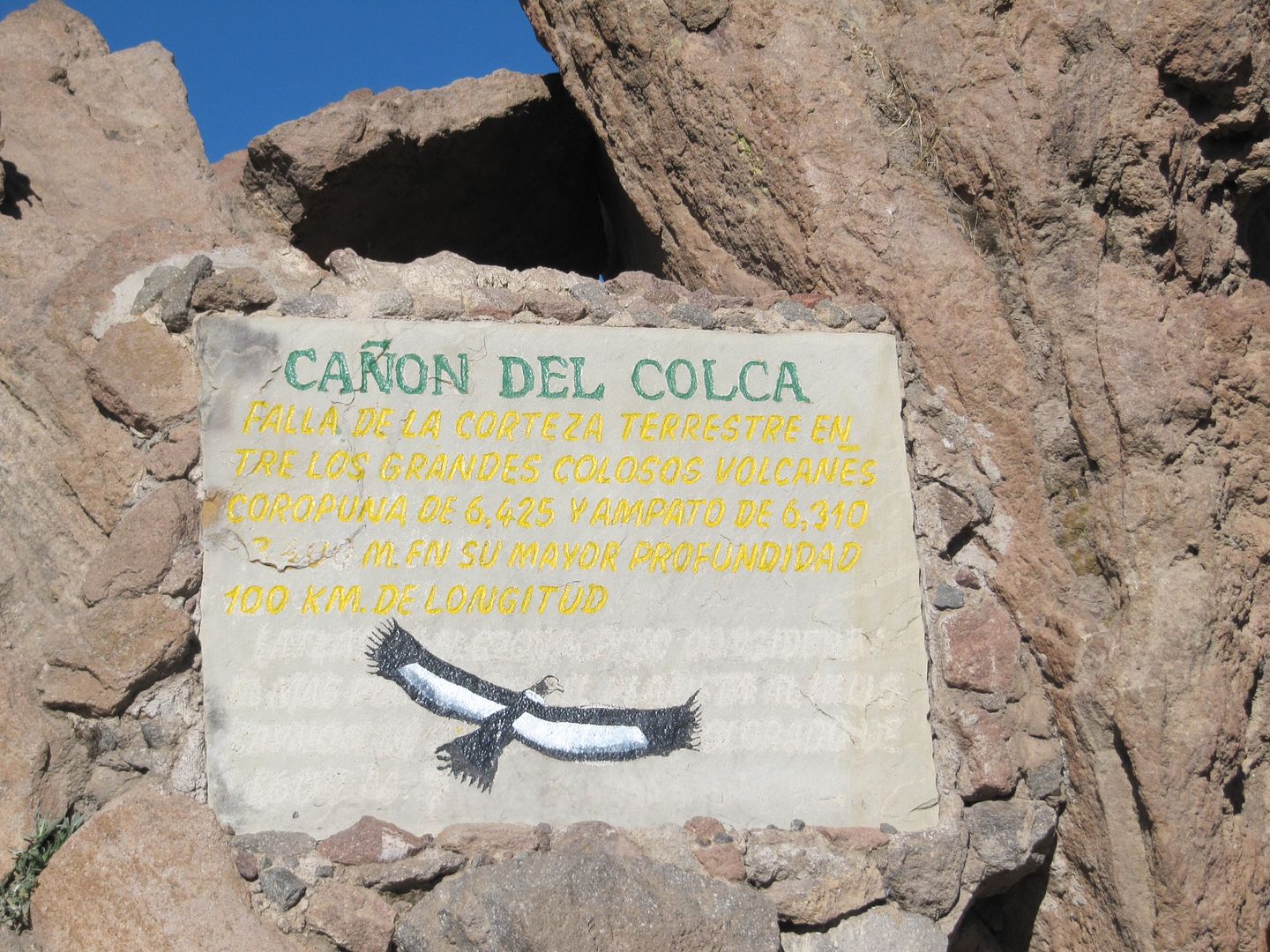 Our next stop was Chivay. We had a long drive to reach it, passing through a snowstorm at around 4500m. Much of the journey was over rough roads and so it was boneshakingly bumpy - literally. We passed some of the time playing cards, but frequently had to grab hold of the ones on the table to stop them from falling off from the vibrations.
Our next stop was Chivay. We had a long drive to reach it, passing through a snowstorm at around 4500m. Much of the journey was over rough roads and so it was boneshakingly bumpy - literally. We passed some of the time playing cards, but frequently had to grab hold of the ones on the table to stop them from falling off from the vibrations.Chivay is a small town on the edge of the Colca Valley. There is very little there and although the tourists come here now, the valley and canyon were only 'rediscovered' by the outside world, including much of Peru itself, in 1979, so the area is still quite traditional compared to most places. It was only then that they built the road around the canyon, so even access to the villages and towns was quite limited until the 1980s.
 |
| Colca Canyon |
Our guide for the day told us that the Colca canyon and valley, and the river that runs through them, are named after the caves found in the mountains either side. Apparently the original settlers created cave rooms in the mountains which captured the cold air and which they used to store their food. These Colcas were their refrigeration system, and the area is named after them.
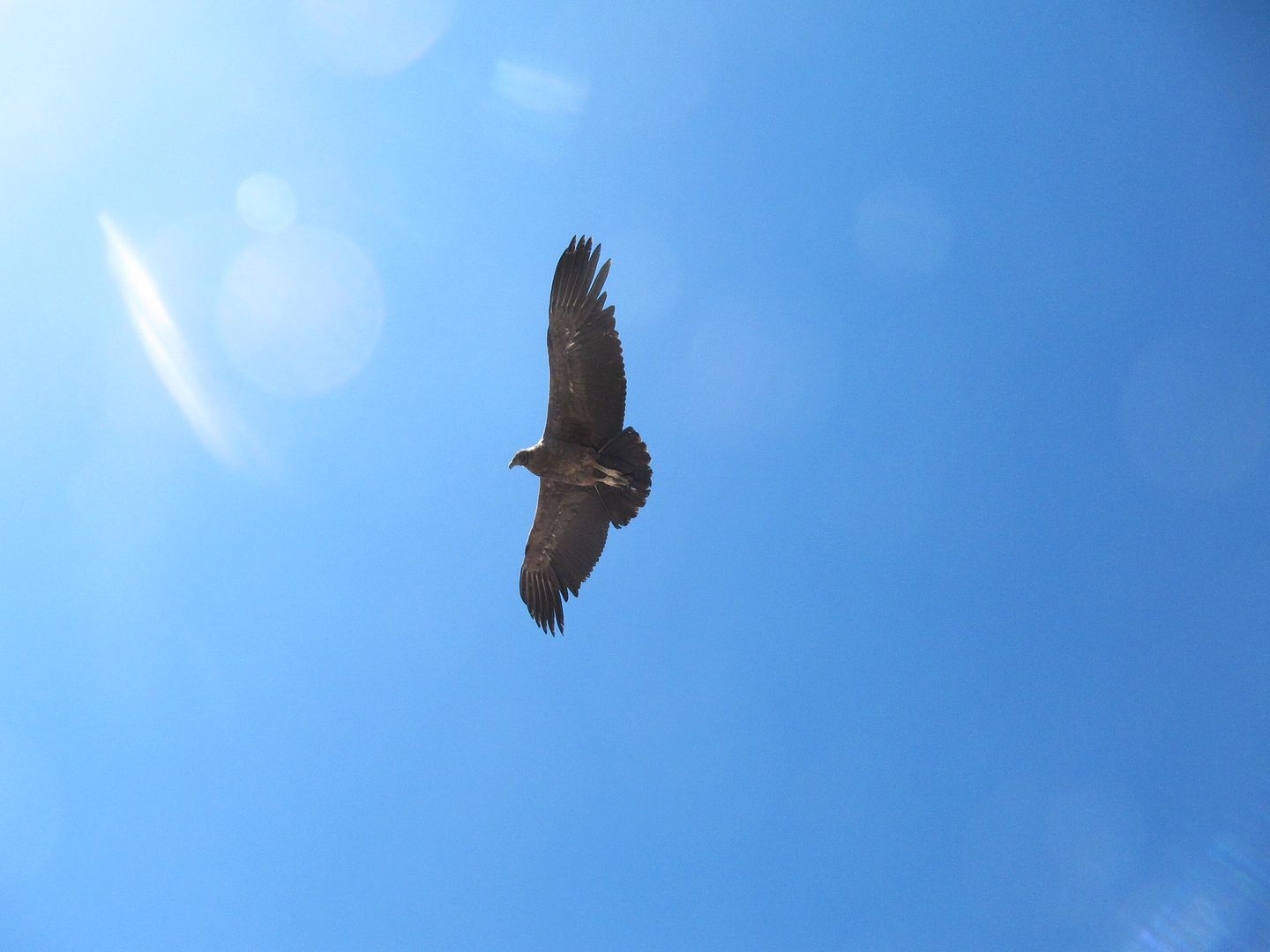 |
| Condor at the Colca Canyon |
The canyon is the deepest in the world and is certainly very impressive. Both the valley and the canyon are worth a visit for themselves, but the main reason that people come here is to try to catch a glimpse of the condors.
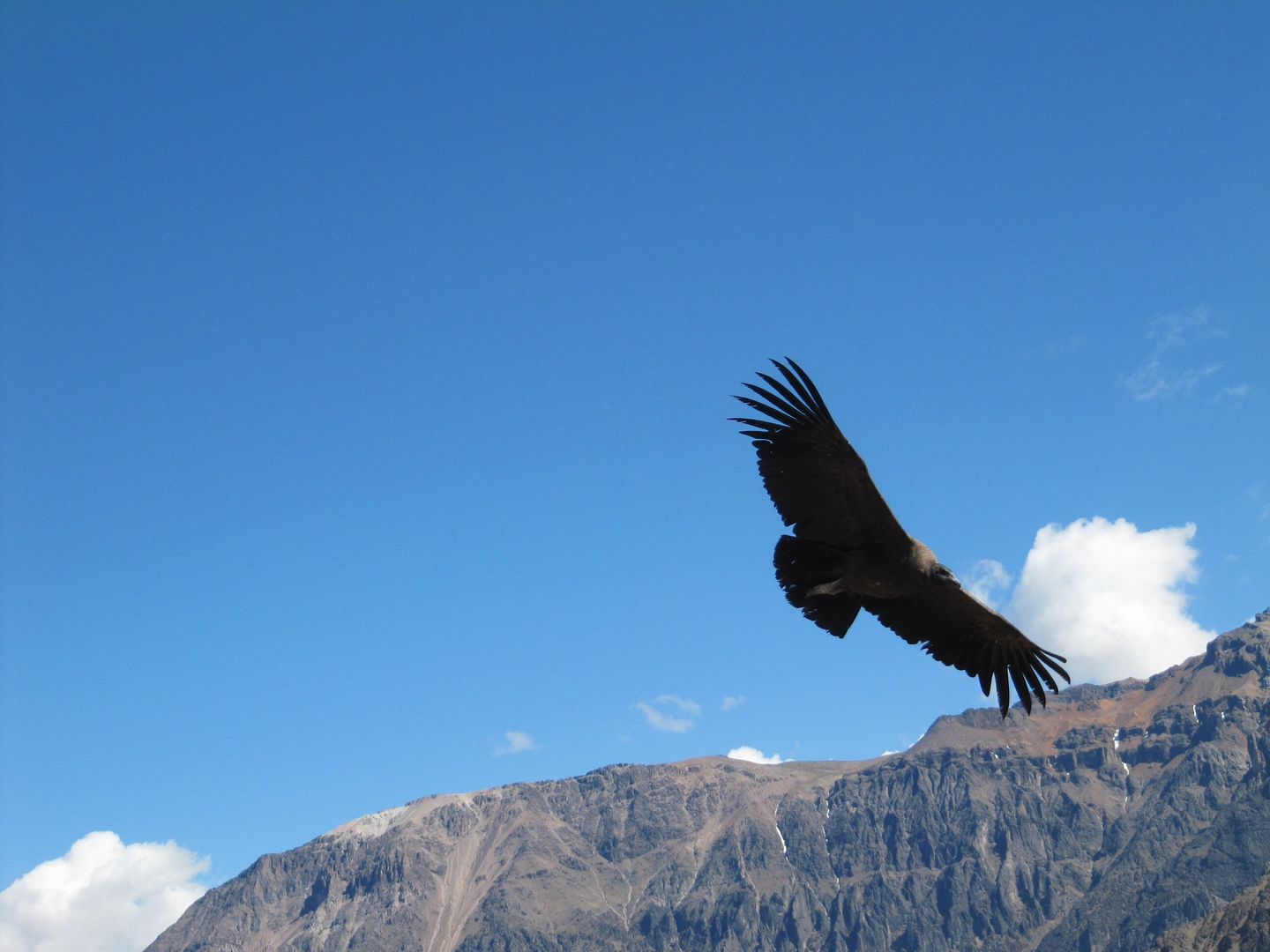 |
| Condor at the Colca Canyon |
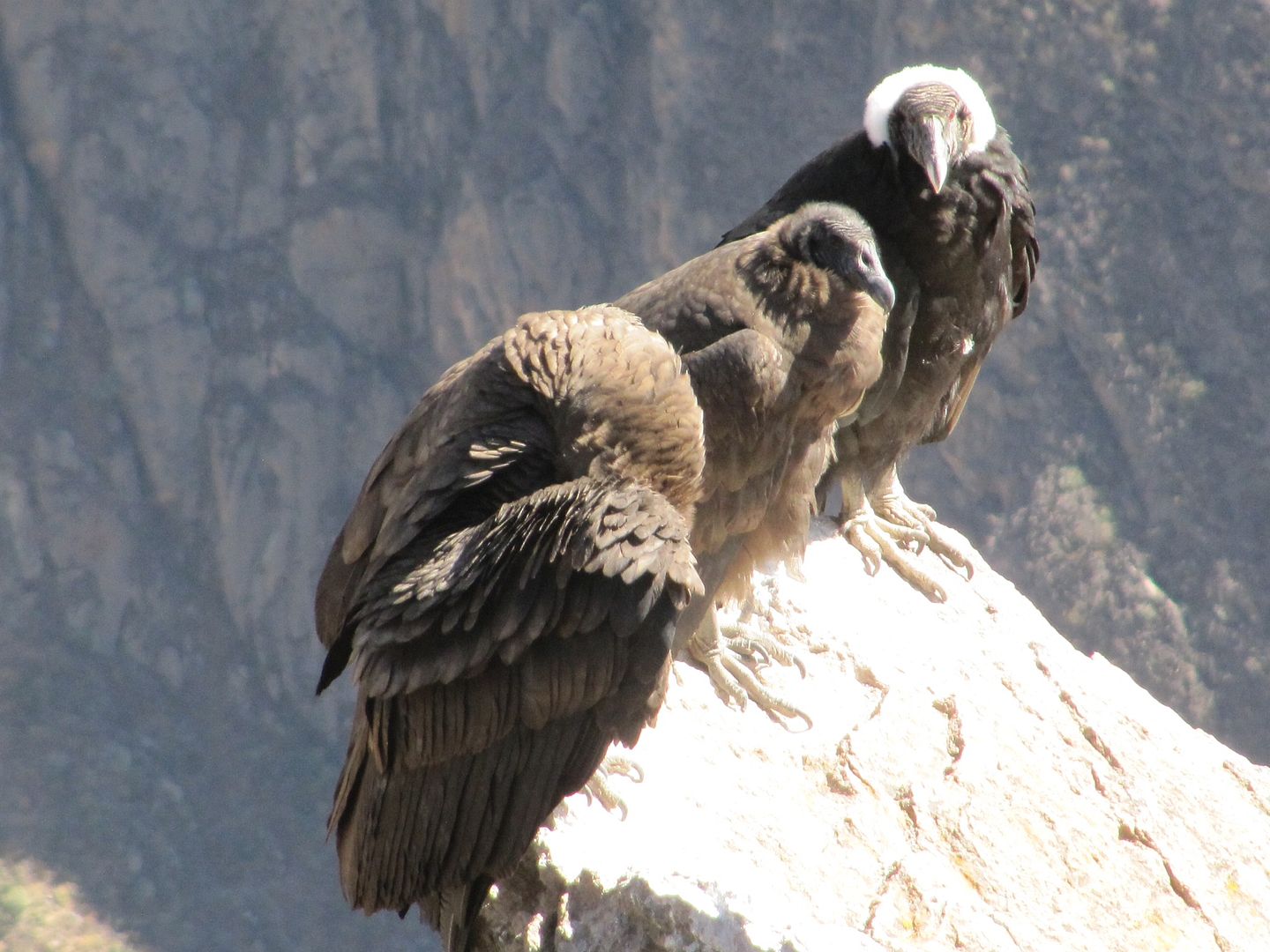 |
| Condors at the Colca Canyon |
When we arrived at the lookout site, we were just about the only people there, so we could get the best viewing spots over the edge of the canyon. And almost immediately we spotted a couple of condors a little way off and below us. Then we waited to see if they would get closer.
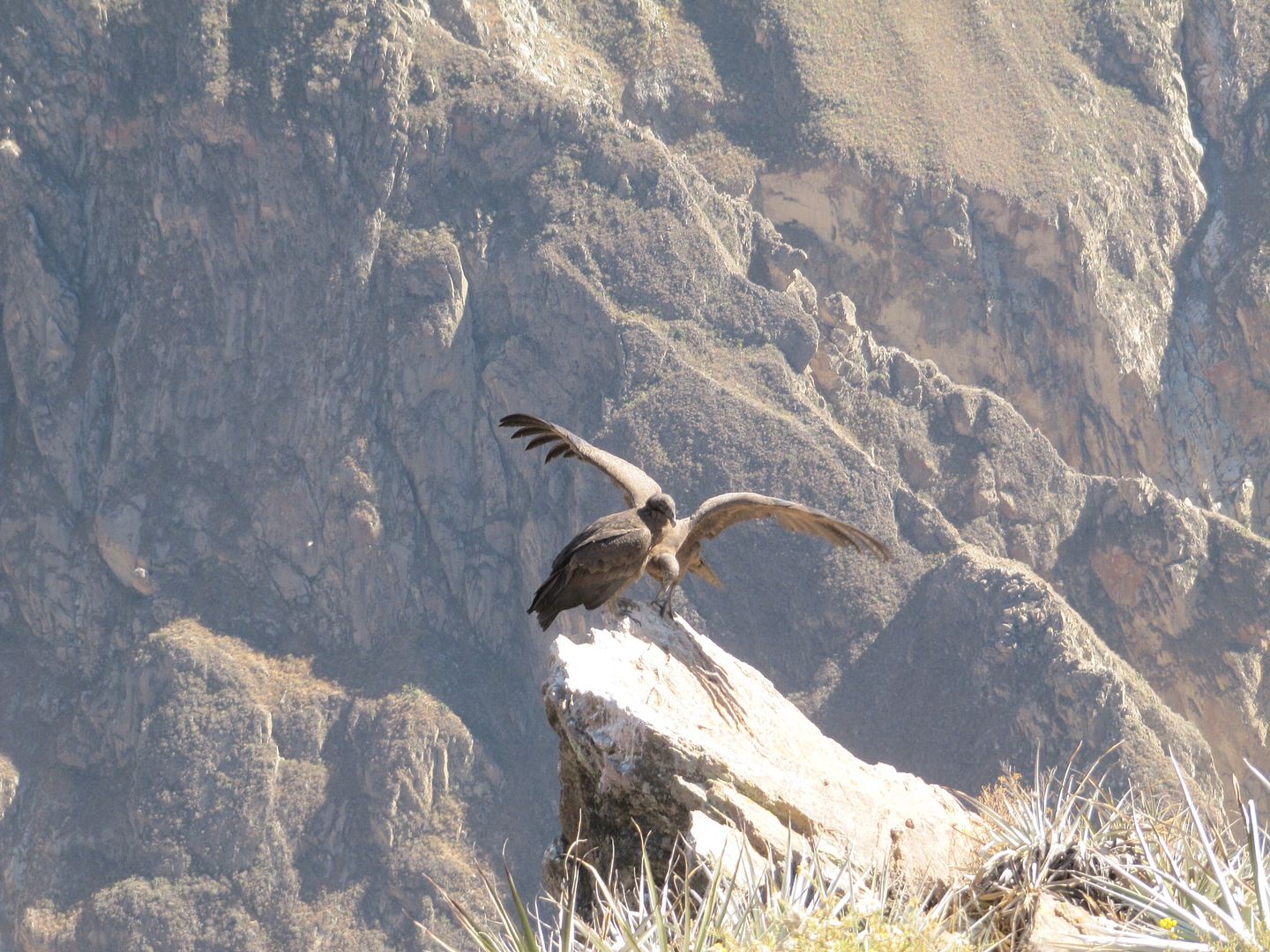 |
| Condors at the Colca Canyon |
It took a while, but gradually they did get closer. A lot closer. These huge birds, with an average wingspan of 3.4metres, circled below us for a whole and then directly over our heads. A few perched most helpfully on a rock about 20metres away from us, so we had an excellent view of them as well as those flying above us.
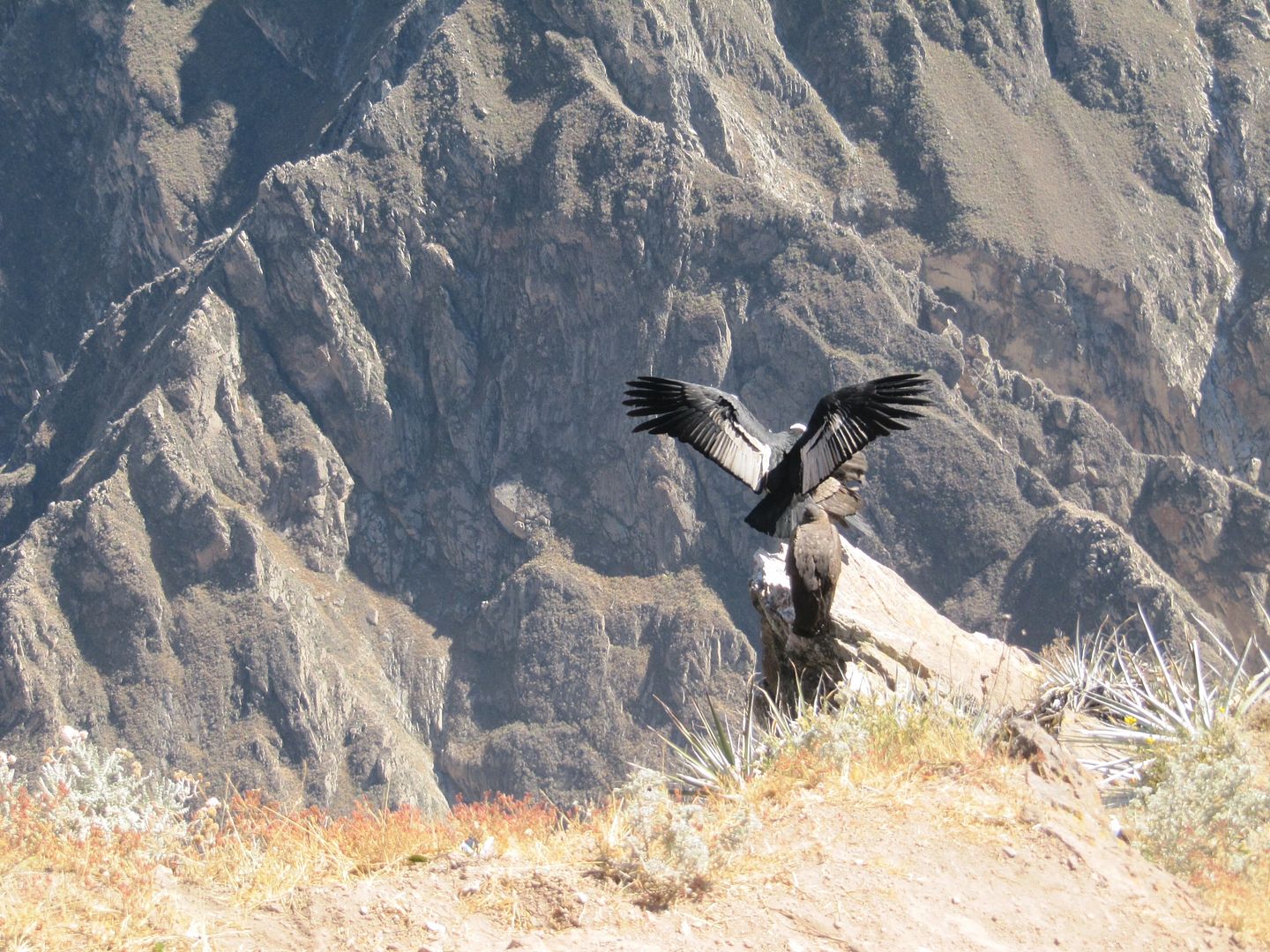 |
| Condors at Colca Canyon |
I'm not especially into our feathered friends, but still this was quite an exciting experience to see them so close and the ease with which these huge birds glide around. We managed to count eight condors, some younger brown ones and a couple of older black and white ones.
 |
| Nic with llama and hawk |
After condor watching was over we set off back through the valley and stopped at a couple of villages along the way. Nic had his picture taken with a llama and a hawk in the first village - not touristy at all !
 |
| Izzie, gossip llama and llama |
More amusing though was our driver Izzie's encounter with the llama. Izzie has a woollen hat that looks like a llama, generally known as gossip llama. She was wearing this hat when she met the llama in the town and it seems the real llama wasn't overly impressed as it tried to bite it.
 |
| On the roof seats at Colca Canyon |
Back in Chivay, we had a buffet lunch before heading back for a relaxing afternoon and evening.
Raqchi
It's not too far from Cusco to Raqchi, so for a change we had a nice relaxed start time. Probably just as well as the previous night both Nic and I had succumbed to the bug going around the group.
Raqchi is a small town that used to be where people bringing their foods to Cusco would stop off. As a result, the people of Raqchi became known for the ceramics that they made to store these foods. More recently, they have embraced tourism by offering homestays with the villagers. Which is why we were there.
The homestay was an interesting experience if a little awkward at times. I was very pleased that we had learnt a bit of Spanish, as Stella spoke no English, so without it we would not have been able to have any proper conversation at all. That would have been a shame as that was really the main benefit of the homestay.
 |
| Raqchi, Peru |
We arrived in Raqchi in the pouring rain. The town square was a mudbath and we had to park the truck next to the door of the church to unload the rucksacks without them and us getting completely drenched. Nic and I and another couple were allocated to Stella and we set off with her to her home. It was a good twenty minute walk on very muddy tracks in the still pouring rain. By the time we got there our trousers and feet were soaked and spirits were dampened to say the least.
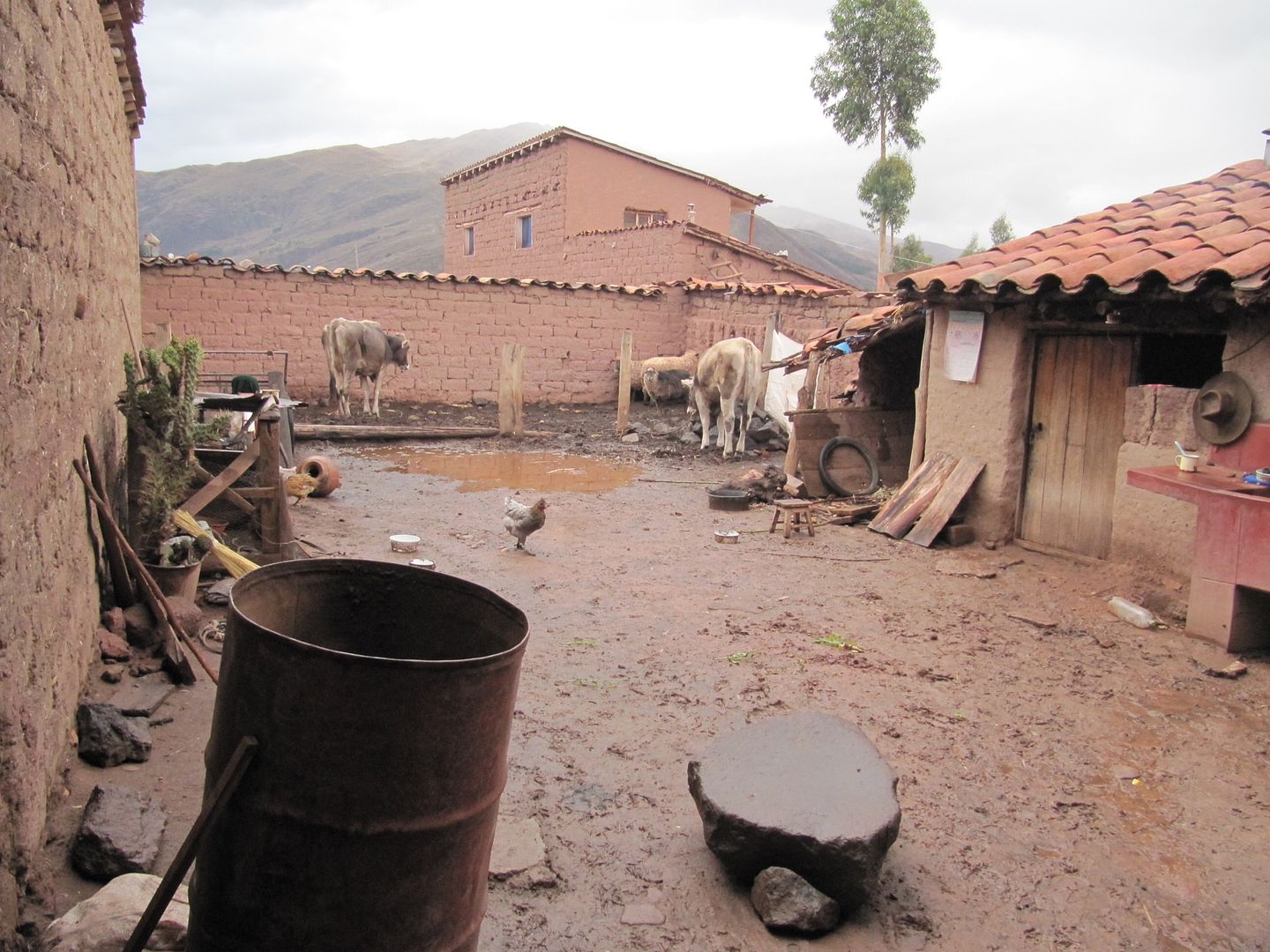 |
| Stella's house, Raqchi, Peru |
We really didn't know what to expect, but we were shown to two rooms on one side of a double courtyard. Stella showed us where the toilet was and then left us to our own devices while she cooked us dinner. We weren't sure whether we were supposed to stay put or go and find her, but we took our lead from the fact that she would have come and got us if that was the idea It felt a bit strange just sat in someone's home like that, but we watched the chickens and dogs and played some cards while we waited.
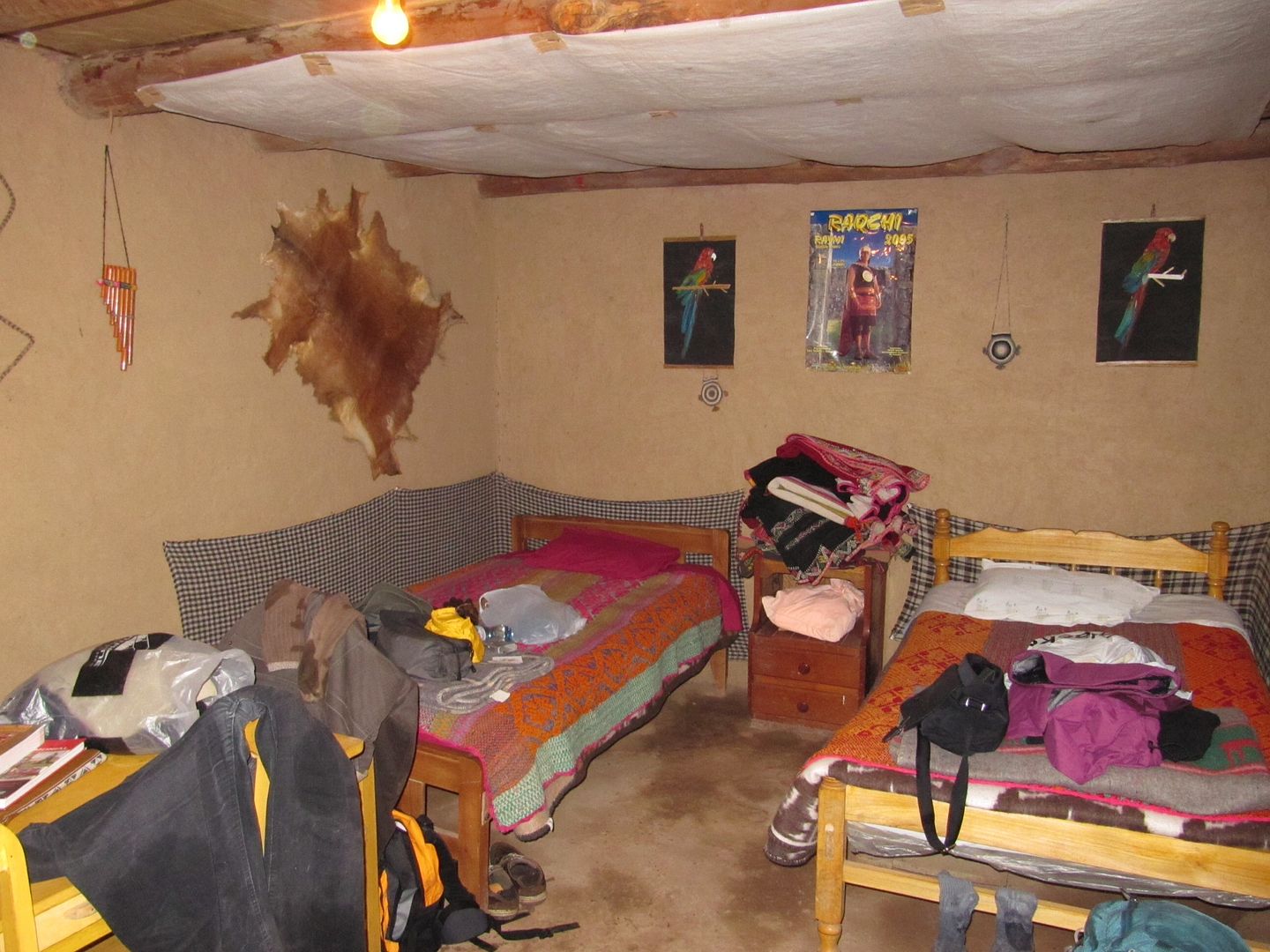 |
| Our room, Raqchi, Peru |
We had expected to go into Stella's part of the house for dinner, but instead she brought brought it to us in our room. We had been told it would be starch, starch and more starch and they weren't wrong. We had a potato and sweetcorn soup to start with, then chicken with rice and potatoes. After dinner, Stella came and sat with us and Nic and I used our limited Spanish to have a conversation of sorts. It was nice to have the opportunity to ask her about her and her family and how they lived.
 |
| Raqchi pottery, Peru |
In the morning, we had to be up and ready for breakfast at 6am. Breakfast was some fruits in condensed milk, a hot hardboiled egg, a pancake of sorts, bread, cheese and .... potatoes. After breakfast Stella led us back into the town. We thought it a bit odd that someone had also scooped up the four puppies and brought them with us, but we discovered that this was because someone had come into town to do vaccinations and it was time for the puppies to have theirs. When we got there the square was full of rather disgruntled cats and dogs!
We were then given a display of the traditional pottery making before the inevitable opportunity to but gifts. This is always difficult, as you want to repay the hospitality you have been shown by buying something, and it's not expensive, but we just can't afford the space and weight in our rucksacks at this stage. But this time we did manage to find a couple of very small things that we could take with us.
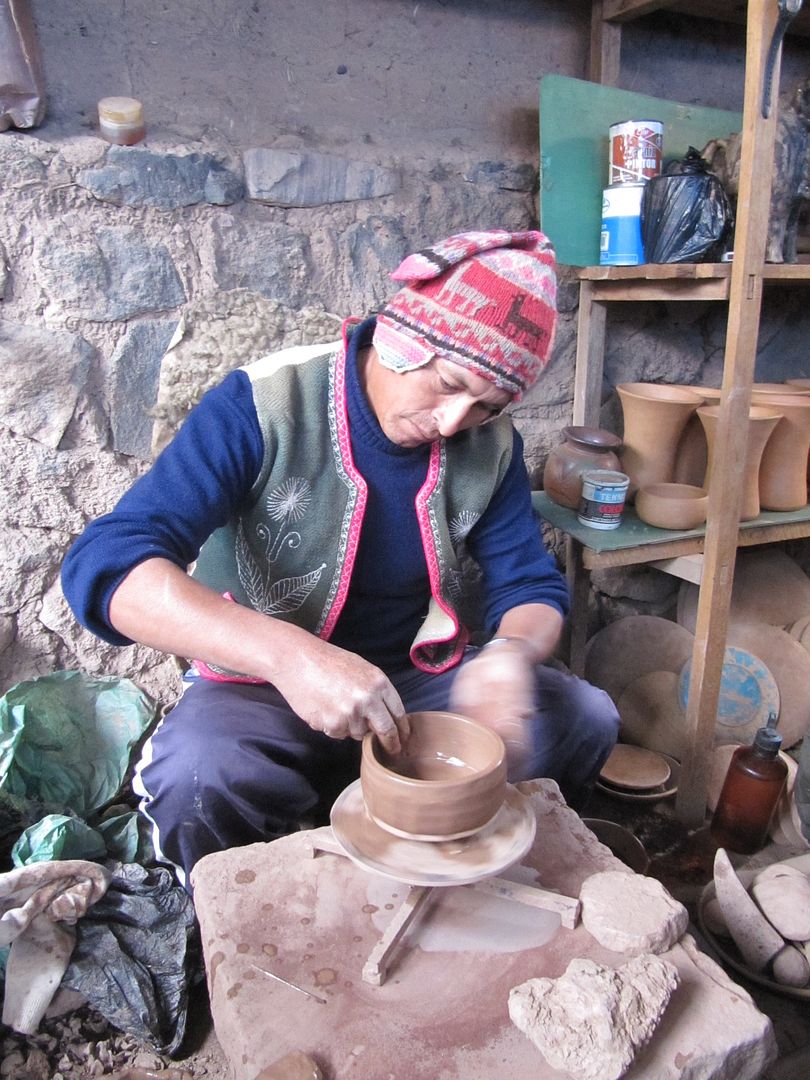 |
| Raqchi pottery, Peru |
We then had a mass goodbye session with the ladies who had hosted us all and were given some Andean cross necklaces before we set off on our way to Chivay.
The homestay was an interesting experience if a little awkward at times. I was very pleased that we had learnt a bit of Spanish, as Stella spoke no English, so without it we would not have been able to have any proper conversation at all. That would have been a shame as that was really the main benefit of the homestay.
All change in Cusco
Cusco was another change of leg, but unlike the others, we had an overlap of the new and old groups for the duration of the treks.
So we first said hello to four new group members. Tina and Matt from Reading are here on their honeymoon, Ben from Australia is here as part of a year trip before taking up a new job, and Luke is from Canada. Ben will be with us all the way to Cartagena, but the others only go as far as Lima.
And as we left Cusco, we said goodbye to Gemma and Elliott; Leoni, Fiona and Drew; Stacey and Kas; and Aine.
So eighteen of us continue on the next leg from Cusco to Lima.
So we first said hello to four new group members. Tina and Matt from Reading are here on their honeymoon, Ben from Australia is here as part of a year trip before taking up a new job, and Luke is from Canada. Ben will be with us all the way to Cartagena, but the others only go as far as Lima.
And as we left Cusco, we said goodbye to Gemma and Elliott; Leoni, Fiona and Drew; Stacey and Kas; and Aine.
So eighteen of us continue on the next leg from Cusco to Lima.
Machu Picchu
 |
| Ollantaytambo, Peru |
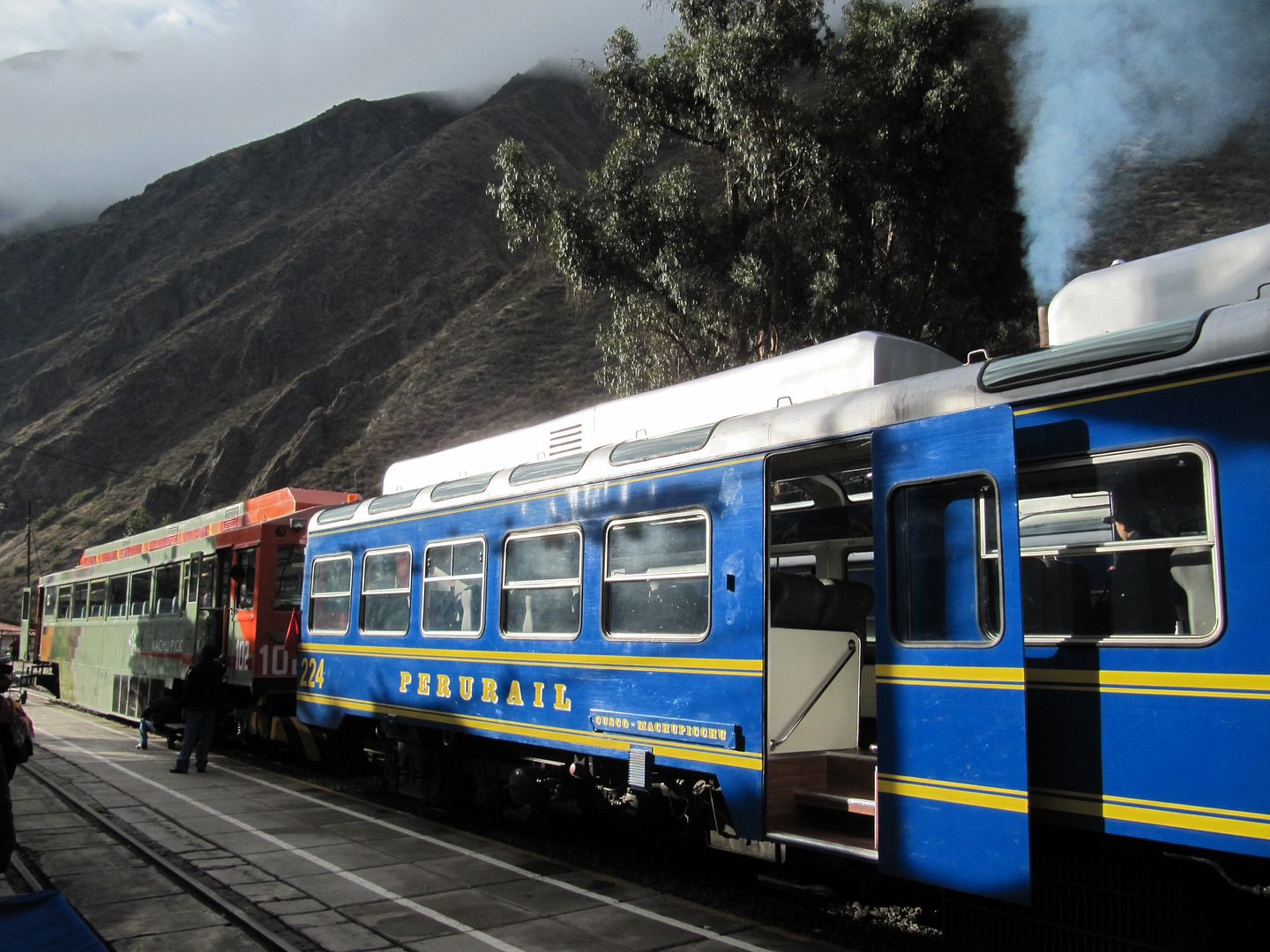 |
| Machu Picchu train |
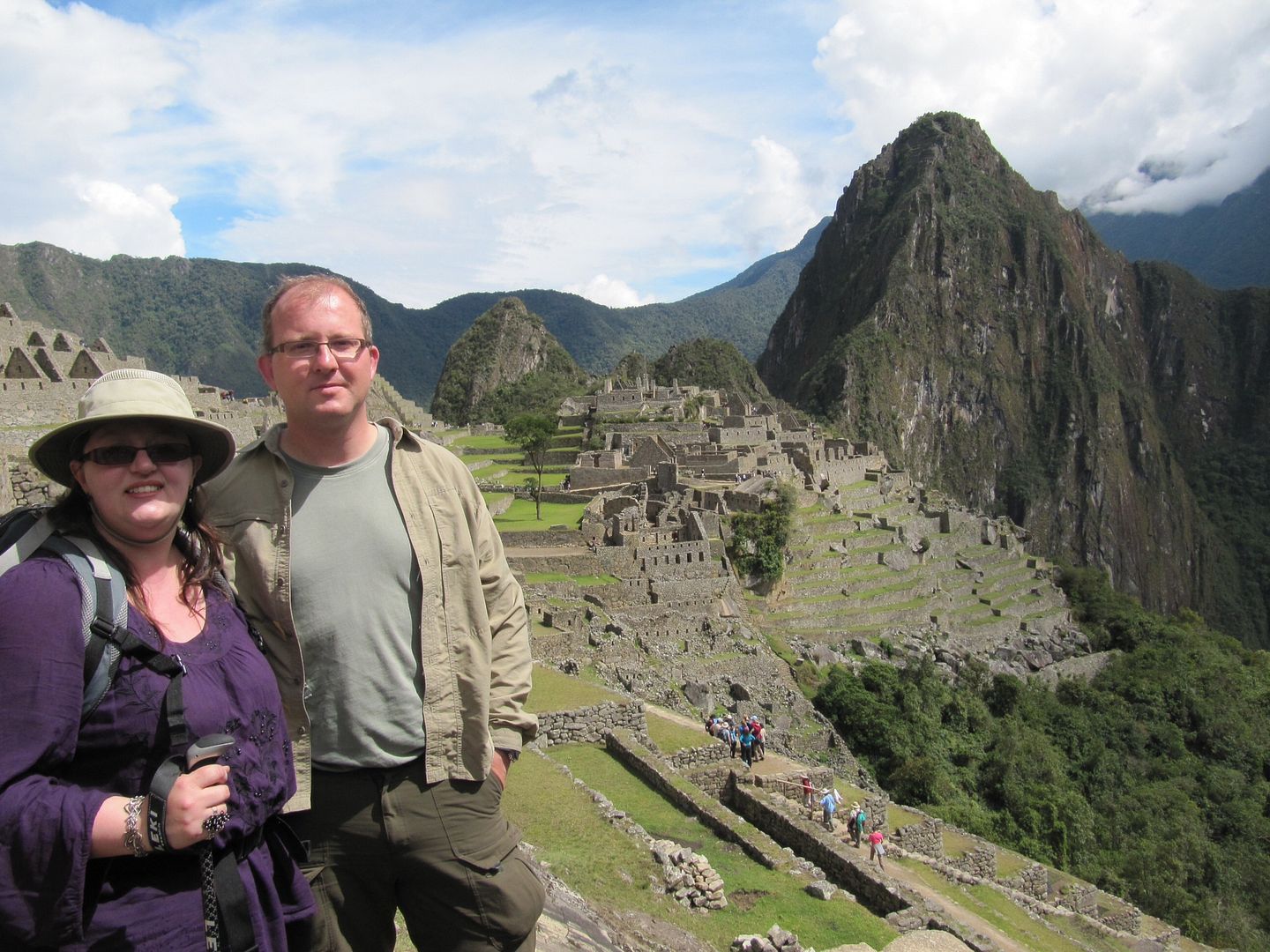 |
| Add caption |
So was Machu Picchu all that it is cracked up to be? Whilst I had been looking forward to going there, it had never been a burning ambition. But it is one of the new modern wonders of the world, even if Karl Pilkington didn't feel the need to make it all of the way there.
 |
| Machu Picchu, Peru |
It certainly is in a beautiful setting, and that makes it amazing. The way that it is nestled on a plateau between mountains is really spectacular, and the near and tidy patchwork of the ruined buildings looks good.
 |
| Machu Picchu, Peru |
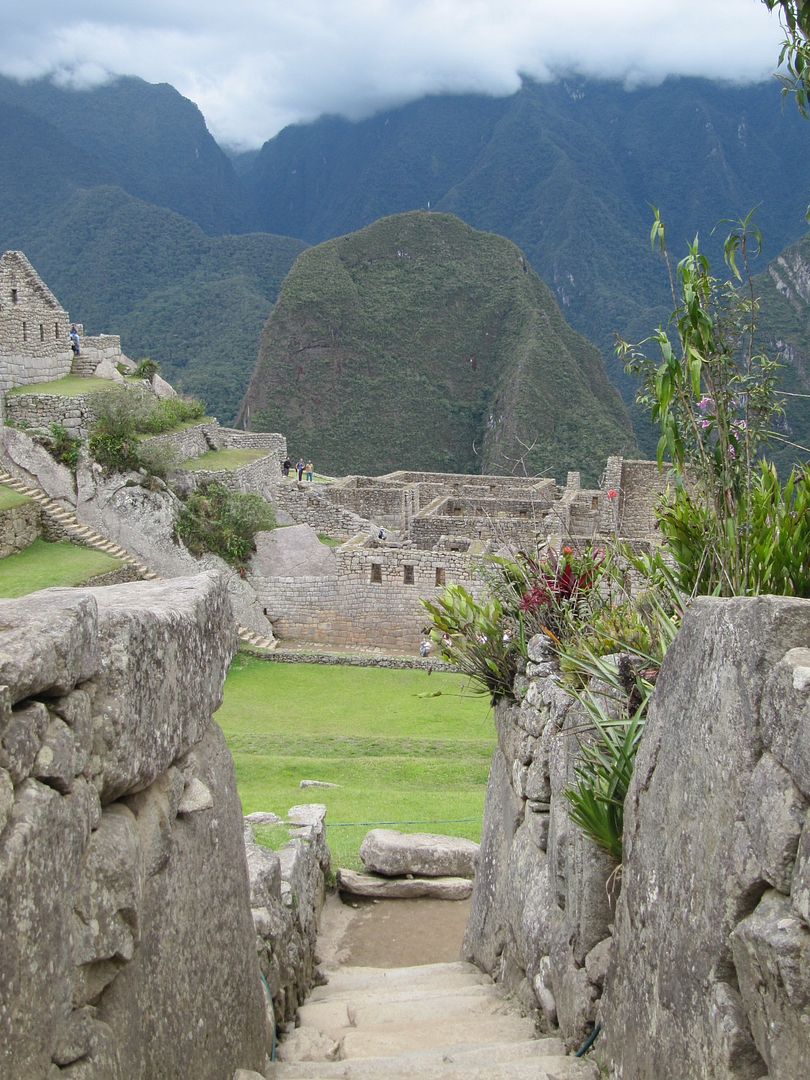 |
| Machu Picchu, Peru |
But is it really that impressive? I initially was comparing the Inca ruins with Stonehenge and was most impressed, but that is not at all the right comparison. Stonehenge was built in around 2000 BC, whereas they calculate that the Inca town was built in about 1480 AD. By that time in the UK we had cities, castles and cathedrals. Tudor London obviously had some way to develop yet, but it was much further forward than small stone settlements and terraced vegetable plots.
 |
| Machu Picchu, Peru |
 |
| Machu Picchu, Peru |
I had always assumed that the Incas had needed to lug the stones for the settlements up the mountain, which would have been impressive just for the effort, but in fact they quarried the stone on site.
 |
| Machu Picchu, Peru |
So overall I am not especially impressed by the Inca's achievements, but that doesn't take away from how beautiful Machu Picchu looks. It is still well worth a visit.
 |
| Machu Picchu, Peru |
 |
| Machu Picchu, Peru |
 |
| Llama at Machu Picchu, Peru |
To Trek or not to Trek?
I had spent a long time trying to decide whether or not to do the trek, and up to a few days before I still hadn't decided. Balancing my definite lack of fitness, especially uphill, and my troublesome knees, with the obvious feeling that this is something that should be done, was not easy.
We hit the first site Sacsayhuaman early enough to have the place almost to ourselves. Our guide for the trek, Smitty explained to us the process they used to build this sun temple from huge great lumps of rock, and showed us the rocks that were, with a bit of imagination, shaped like llamas or other symbolic animals. Each piece of rock had to be individually shaped to fit neatly into place.
We made our way very tentatively through one of the pitch black tunnels, all carefully holding on to the person in front, mindful of the student who had gone missing and never been found.
From there we drove on past the Sacred Valley of the Incas, which is the fertile valley around the river, and on Pisac, with it's huge terraces cut into the hillsides, where the incas would grow a huge variety of vegetables including hundreds of varieties of potato.
We saw the holes in the hillside opposite where they would bury their mummified dead, and the irrigation system they used to get drinking water.
Then after lunch we drove into the valley to start the trek. By this time, seeing the mountains in front of me, I was seriously starting to wonder whether I was doing the right thing, especially as it had started to rain, but we left our dufflebags with the porters and mules and set off.
And straight away we started up hill. And more up hill. And more uphill and .... well you get the idea! I kept up with the group for a while, but gradually started to fall back as we hit the steeper parts. Now I had been promised that unlike the classic trail there were no steps. Technically that was true, there were no actual cut steps, but when you have to clamber your way up from one rock to another, it may as well be steps, so I found it hard going.
So on we went. Up hill to varying degrees of steepness almost constantly, over some decidedly difficult terrain. I can tell you I was very grateful to have walking poles (thanks again to The Girls for those) but even so I had to stop regularly to recover my breath. The photo is about halfway up and you can see the valley where we started from way down below.
Three hours in, and quite knackered, we had done the worst of today's route, but I was some way behind the others and the guide had realised that I wasn't going to make it to the camp before it got dark. So he put me on a mule for the rest of the journey.
But while I had an easy last section back, poor Nic didn't. Because he had walked with me, he had to cover the last bit extra fast to catch up and get back before it was dark. He managed it but he was knackered by the end.
So we arrived at the first camp, which was in a lovely setting, although disappointingly we had no interraction with the local community who we were staying with. In the photo of the campsite you can see the mountain we would be going up the next day.
The good thing about these treks though is that all you have to do (all!!) is walk with your daypack, the porters do everything else for you. They put up and take down your tents and cook the meals. And they do a really excellent job. They made us a three course meal using just a portable gas ring. And in the morning they brought us tea or coffee and hot water for washing.
But however easy they make the practicalities, you still have to be able to manage the walk in the daylight. And knowing that the walk on day two was so much harder than day one I was seriously worried about the uphills. I didn't want to have to rely on using the mule, partly because it doesn't really feel like I have achieved it if I get on the mule, and partly because other people might need it.
I also knew that if I was going to get on the mule, then there was no way that Nic could walk with me this time, so I would be walking on my own which would be a bit dull too. But the final straw was that the guide told me that he was concerned about my being able to do the steep downhills on day two. He felt that they were too steep and slippery for my knees to cope with properly.
So I figured that if I was worried about the uphills, the guide was worried about the downhills, I didn't want to have to rely on the mule, and I wouldn't enjoy walking on my own, then really it wasn't sensible to carry on. So I arranged with the guide that I would go back the way I had come the next day, rather than carrying on forward. Nic decided he would come back too.
So after a good meal and a cold night in the tent - thankfully OK due to plenty of advanced wrapping up well - we set off back down the hill. We left slightly after the others, but just as we did, one other person from the group started making their way back down the track, having decided to join us. So the three of us took a rather easier four hour journey back to the main road where we picked up an local minibus to the nearest main town and then a cab back to Cusco. By the time the others would have been staggering into their campsite, we were back in Cusco enjoying a hot shower and an afternoon nap! And the others confirmed afterwards that it had been a really hard walk that day, so I have no doubt that I did the right thing in going back.
 |
| Sacsayhuaman, Cusco, Peru |
There were two trekking options available when we booked, the Classic Inca trail of the kings road, which leads to the Sun Gate at Machu Picchu, or the community trek, which does not actually go to Machu Picchu, but instead takes you through a higher pass and spends time with some of local communities on the way.
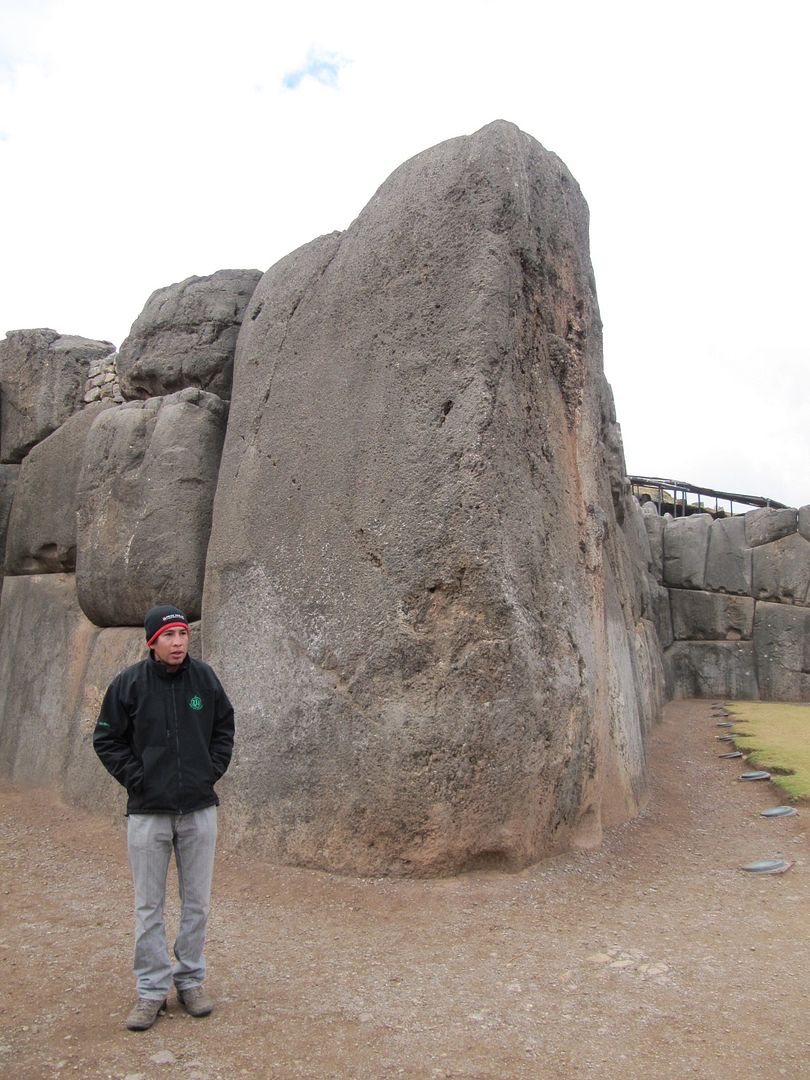 |
| Smitty at Sacsayhuaman |
As you need a permit for the classic, and there are many steps that I knew I would have trouble with, we had booked onto to community trek, with the understanding we could decide not to trek if we wanted to.
I had been concerned by my uphill slog at the ziplining and the walk on the Isla del Sol, and was veering towards not trekking, but was gradually persuaded by others that I could do it after all, so I said yes. I think what swung it for me was that I thought I would regret not trying more than if I tried and failed.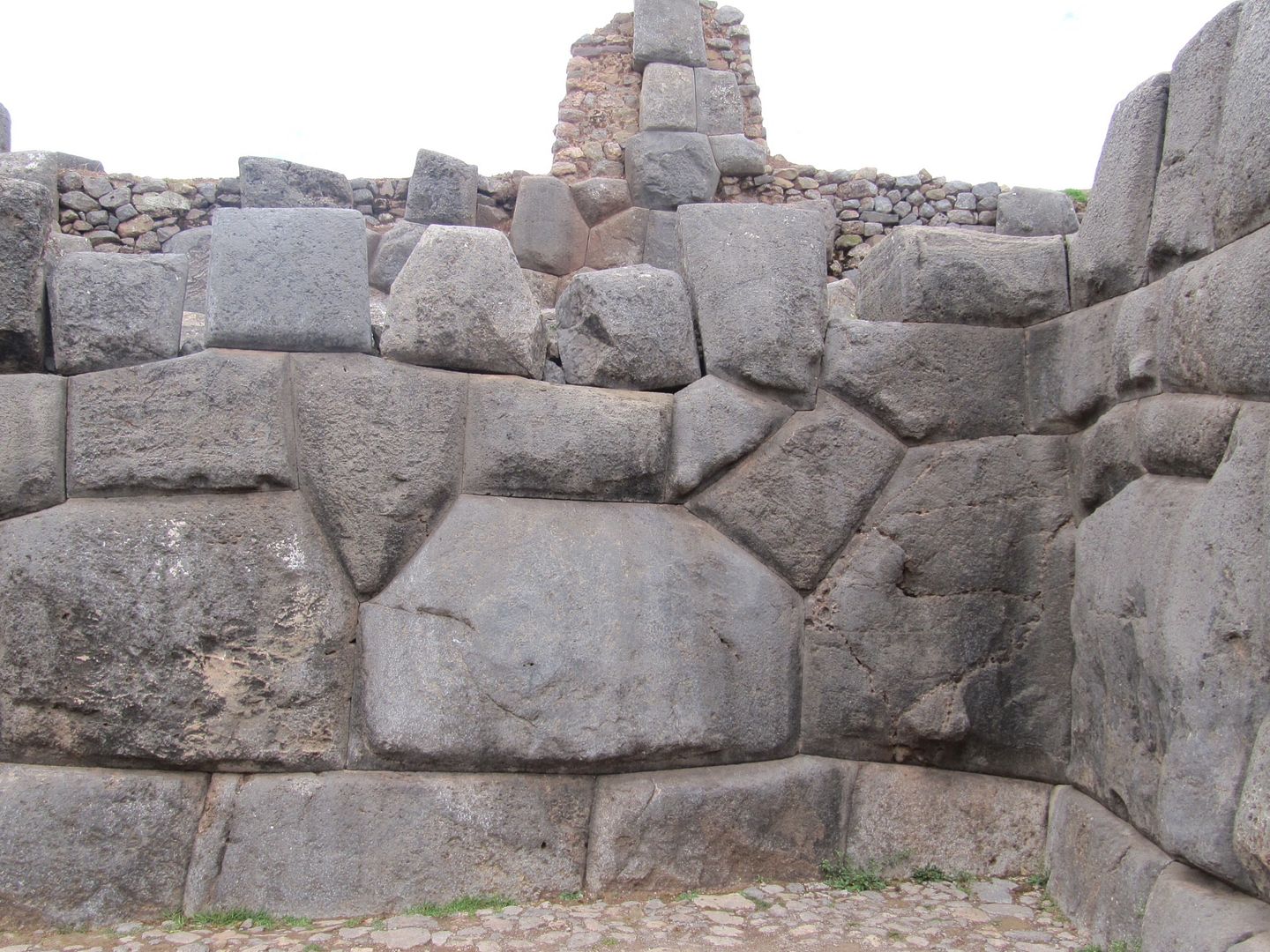 |
| Sacsayhuaman, Cusco, Peru |
So on the Tuesday morning we set off at 6:30am. The plan was to visit two inca sites by coach in the morning, have lunch, then trek for 3-4 hours to the first camp in the afternoon. We then had two full days of trekking to do to reach Lares, where we would go by bus to Ollantaytambo and visit the ruins. Then on the Saturday we would get the train for the last stint to Machu Picchu itself.
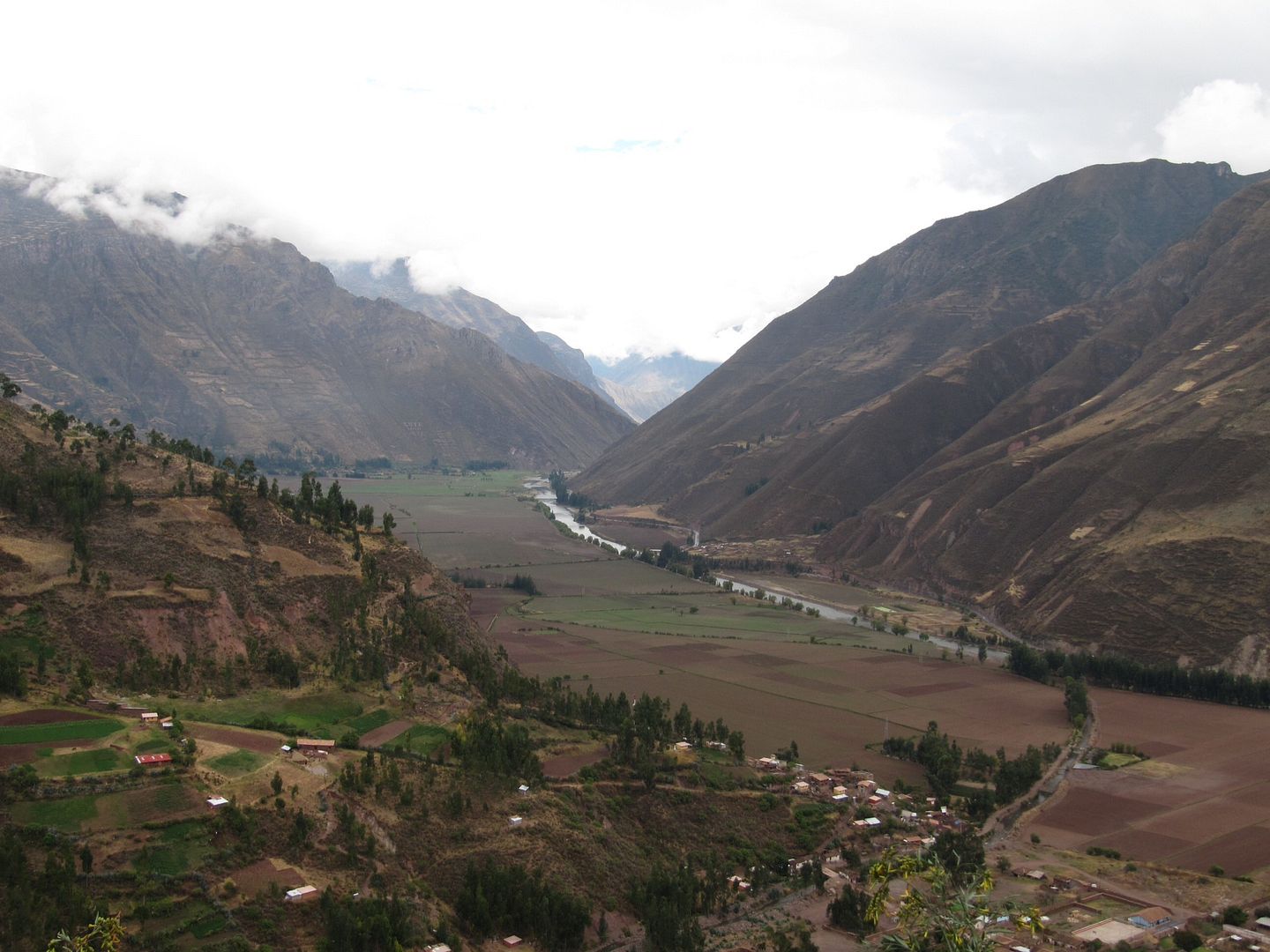 |
| Sacred Valley of the Incas, Peru |
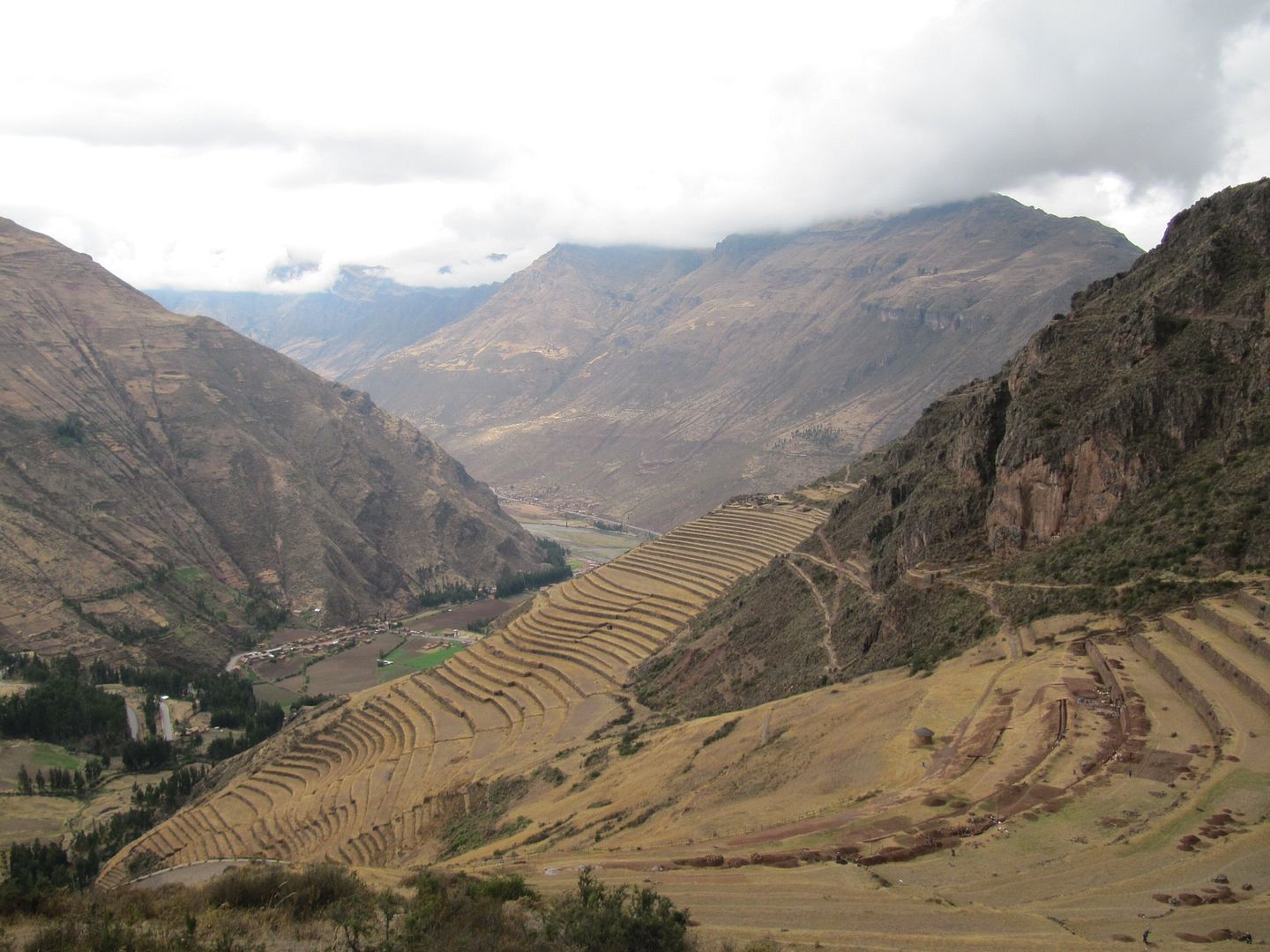 |
| Terraces of Pisac, Peru |
From there we drove on past the Sacred Valley of the Incas, which is the fertile valley around the river, and on Pisac, with it's huge terraces cut into the hillsides, where the incas would grow a huge variety of vegetables including hundreds of varieties of potato.
 |
| Pisac, Peru |
Then after lunch we drove into the valley to start the trek. By this time, seeing the mountains in front of me, I was seriously starting to wonder whether I was doing the right thing, especially as it had started to rain, but we left our dufflebags with the porters and mules and set off.
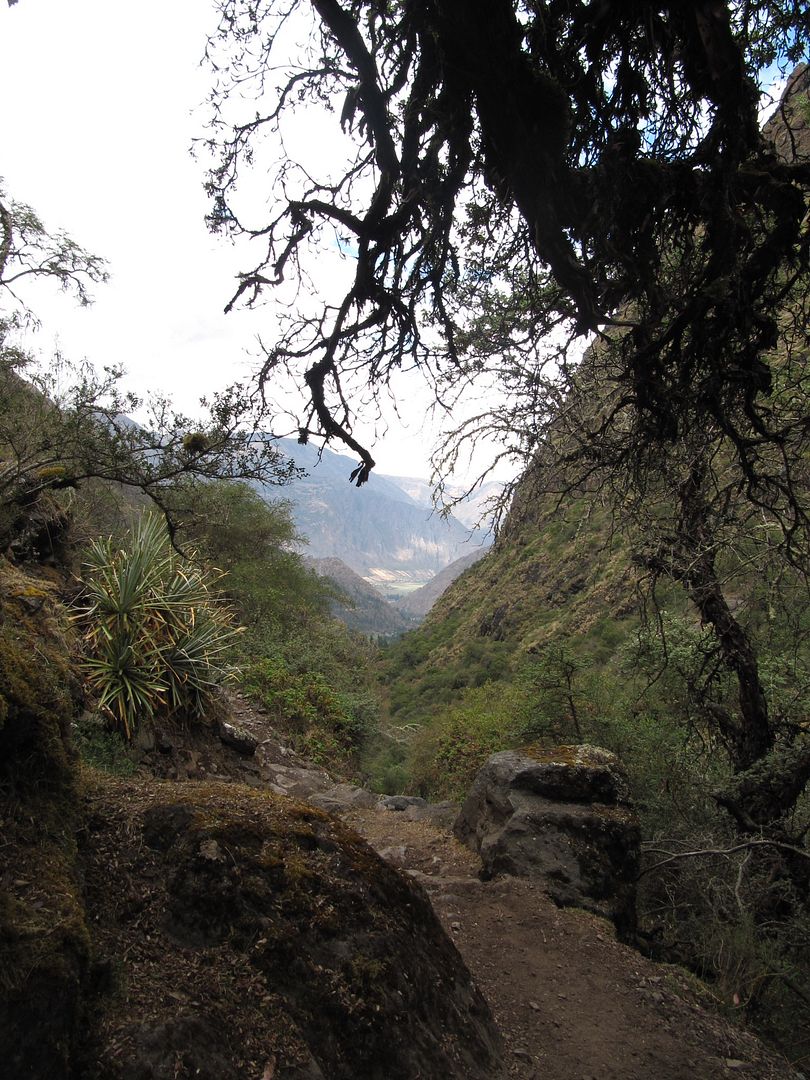 |
| Halfway up on the first trek day |
So on we went. Up hill to varying degrees of steepness almost constantly, over some decidedly difficult terrain. I can tell you I was very grateful to have walking poles (thanks again to The Girls for those) but even so I had to stop regularly to recover my breath. The photo is about halfway up and you can see the valley where we started from way down below.
Three hours in, and quite knackered, we had done the worst of today's route, but I was some way behind the others and the guide had realised that I wasn't going to make it to the camp before it got dark. So he put me on a mule for the rest of the journey.
The mule was fun! I was assured that it was quite strong enough to carry me, but they are fairly small creatures, so you feel a bit precarious on top as they make their way over gravel and boulder tracks. When they go down hill (there were actually a few downhills in this bit) you have to lean back and it feels like you are just going to slide straight off! They also tend to walk right on the edge of the path, so that all you can see is a drop down the hillside, which is quite unnerving. But we made the trip without major mishap, and I have to admit it was quite nice to be able to look around at the scenery rather than just focus on making it up the hill without dying!
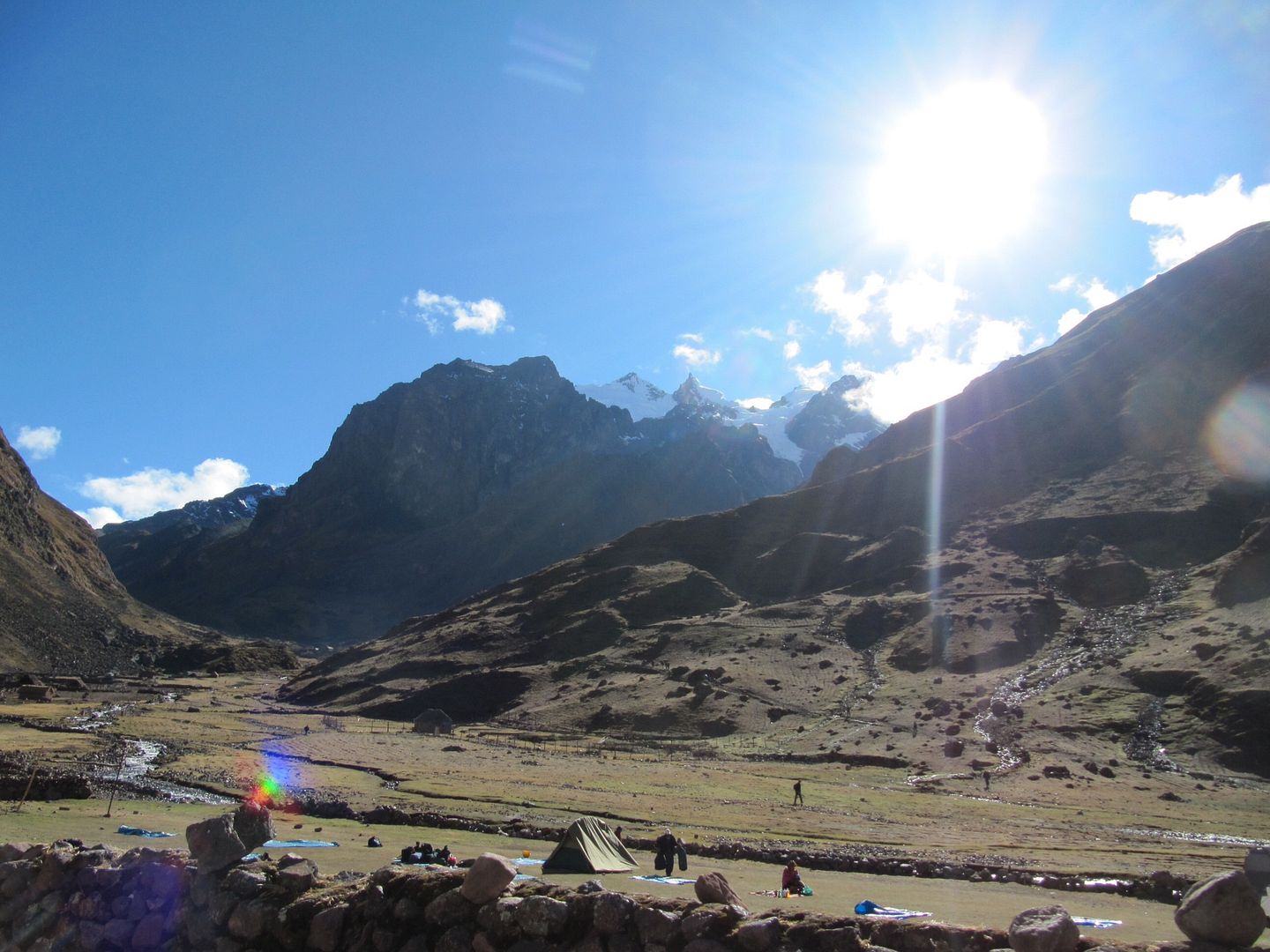 |
| Our campsite on the trek |
So we arrived at the first camp, which was in a lovely setting, although disappointingly we had no interraction with the local community who we were staying with. In the photo of the campsite you can see the mountain we would be going up the next day.
The good thing about these treks though is that all you have to do (all!!) is walk with your daypack, the porters do everything else for you. They put up and take down your tents and cook the meals. And they do a really excellent job. They made us a three course meal using just a portable gas ring. And in the morning they brought us tea or coffee and hot water for washing.
 |
| llamas and mules for the trek |
But however easy they make the practicalities, you still have to be able to manage the walk in the daylight. And knowing that the walk on day two was so much harder than day one I was seriously worried about the uphills. I didn't want to have to rely on using the mule, partly because it doesn't really feel like I have achieved it if I get on the mule, and partly because other people might need it.
I also knew that if I was going to get on the mule, then there was no way that Nic could walk with me this time, so I would be walking on my own which would be a bit dull too. But the final straw was that the guide told me that he was concerned about my being able to do the steep downhills on day two. He felt that they were too steep and slippery for my knees to cope with properly.
So I figured that if I was worried about the uphills, the guide was worried about the downhills, I didn't want to have to rely on the mule, and I wouldn't enjoy walking on my own, then really it wasn't sensible to carry on. So I arranged with the guide that I would go back the way I had come the next day, rather than carrying on forward. Nic decided he would come back too.
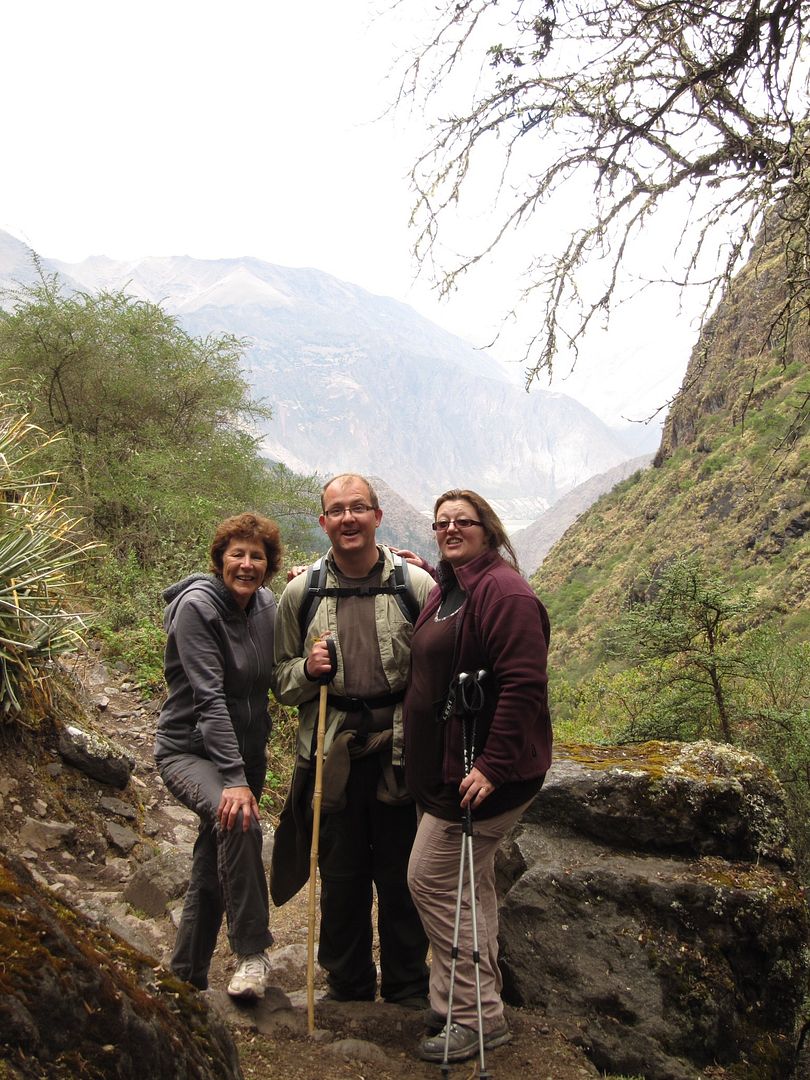 |
| more relaxed on the way down |
Cusco
 |
| Cusco, Peru |
Cusco is a strange place. As the old capital of the Inca Empire and the jumping off point for Machu Picchu, it is a major tourist city. It has a very nice main square in the Plaza de Armes which, unusually for most of South America has lots of flowers in it. The architecture has old Inca bases to the buildings with Spanish structures on top. The city looks good and despite the hills it is a nice place to walk around.
 |
| Cusco, Peru |
 |
| Pigs might fly in Cusco, Peru |
Walking around we were constantly offered massages by those knowing that most people in Cusco either are about to or just have been trekking to some degree of other. And of course there were plenty of souvenir shops, although some had much better quality stuff in them as well as the normal alpaca woollens and carvings of Pachamama.
But overall Cusco was a nice relaxing place to spend a few spare days especially either side of a trek.
The drive to Cusco and dancing on the truck
You may recall the barbecue in Cafayete with the large amounts of meat bought but only in some cases fully eaten on the night. Well one of our group made a bet with his travelling companion that she would not be able to eat all of her meat. The forfeit for him if she could was that he would dance on top of the truck, in his boxers, with the Argentine flag painted on his back.
This may seem like a random forfeit, but he does have form for dancing semi naked with a flag painted on him, so there was a precedent.
However cutting a deal is obviously not his strong point, as if she didn't eat the meat, he would still do the dance but she had to join him. That was irrelevant though, as she ate the meat.
The chosen song was I Would Walk 500 Miles by The Proclaimers, and it was agreed that we would wait until the weather was a little warmer at least. So the day was put off for a while, but this was to be the day.
We found a lovely spot for it, by the side of the road where local women were selling crafts and other vehicles would stop for people to look and buy. The backdrop was beautiful, with hills and the mountain range all around us. It wasn't the warmest day, but it was bearable - unless you were only wearing boxer shorts.
So Sharif (you may as well know who it was as there are plenty of pictures) was painted in the flag, made his was onto the roof of the truck and started to dance, much to the confusion and amusement of the bystanders.
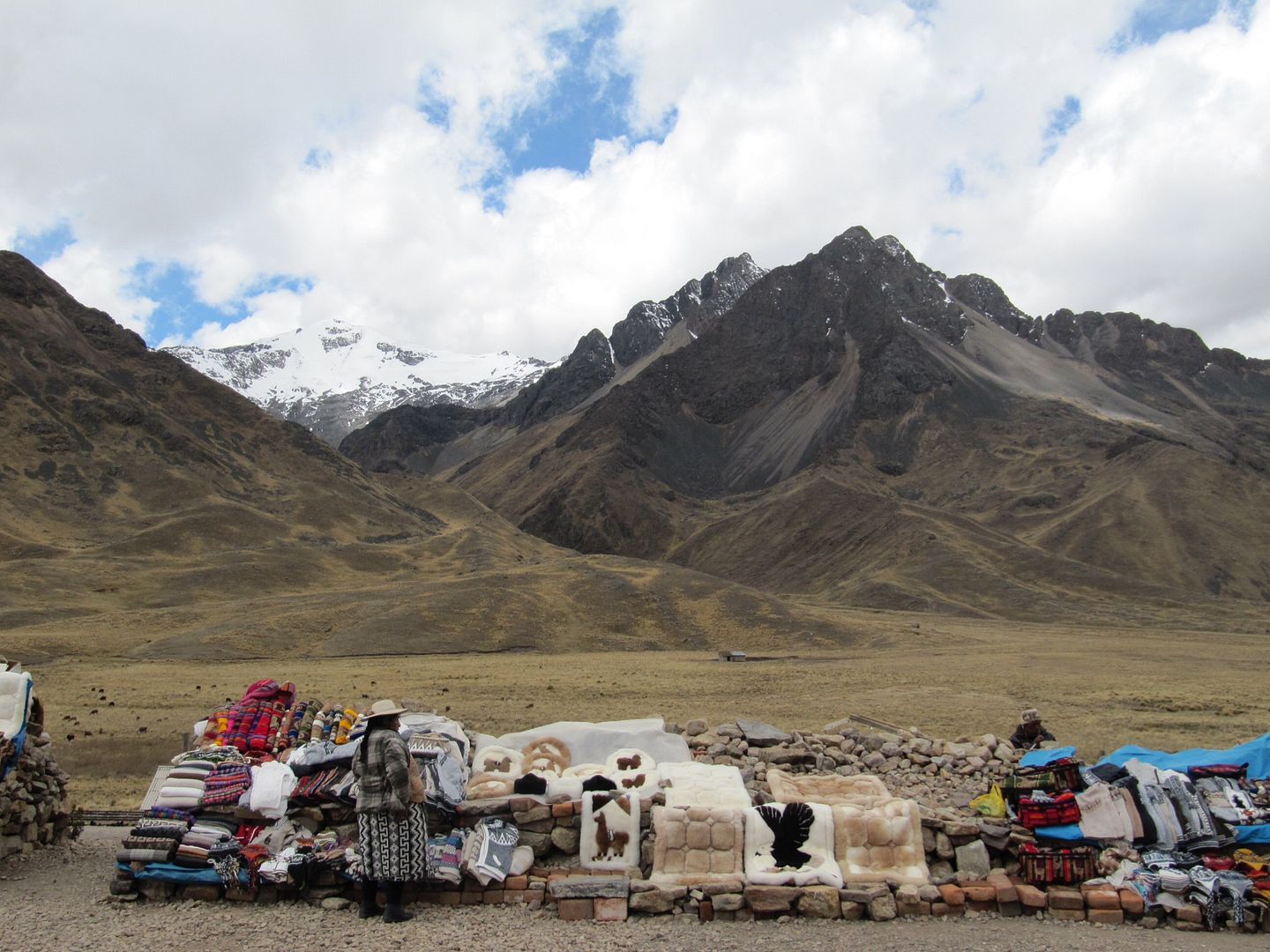 |
| Entertainment stop on drive to Cusco |
We set off from Puno and only narrowly avoided a problem in the first few minutes of the drive, when someone spotted that the back locker door had come open as we went round a roundabout. The shout went up to stop the truck and we came to an abrupt halt. Luckily, with a full truck, everything was tightly packed in so we caught it before anything fell out. One of the group did do a precautionary run back down the street to check we hadn't lost anything and very nearly got into a row over a bag he thought was ours but wasn't!
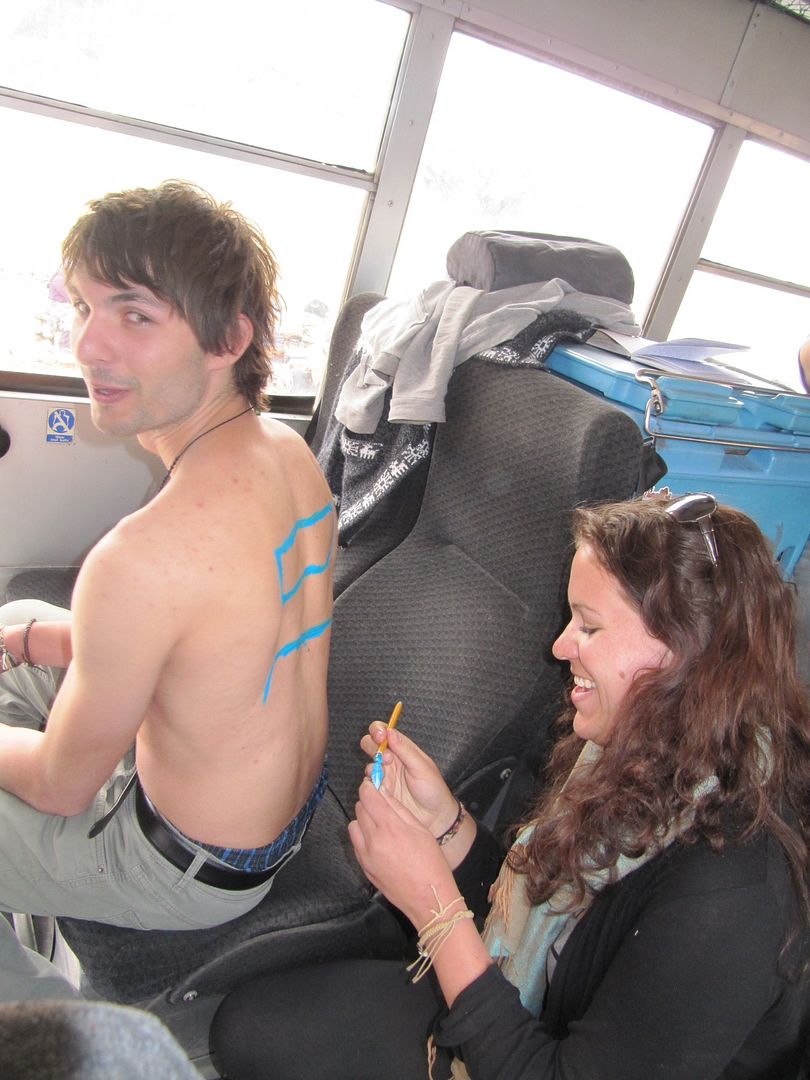 |
| Sharif being painted |
So back on the road, we made our way to Cusco. It was a straightforward drive with a truck lunch on the way, but today we made an extra stop for entertainment.
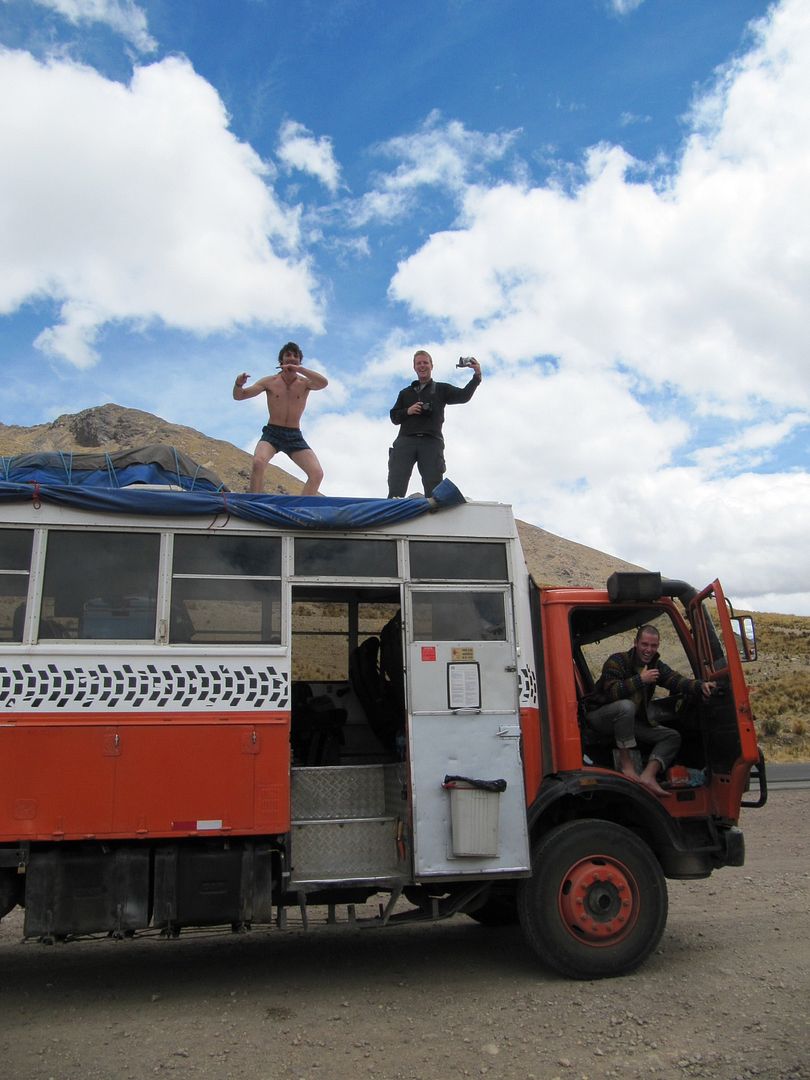 |
| Sharif dancing on the truck |
However cutting a deal is obviously not his strong point, as if she didn't eat the meat, he would still do the dance but she had to join him. That was irrelevant though, as she ate the meat.
The chosen song was I Would Walk 500 Miles by The Proclaimers, and it was agreed that we would wait until the weather was a little warmer at least. So the day was put off for a while, but this was to be the day.
We found a lovely spot for it, by the side of the road where local women were selling crafts and other vehicles would stop for people to look and buy. The backdrop was beautiful, with hills and the mountain range all around us. It wasn't the warmest day, but it was bearable - unless you were only wearing boxer shorts.
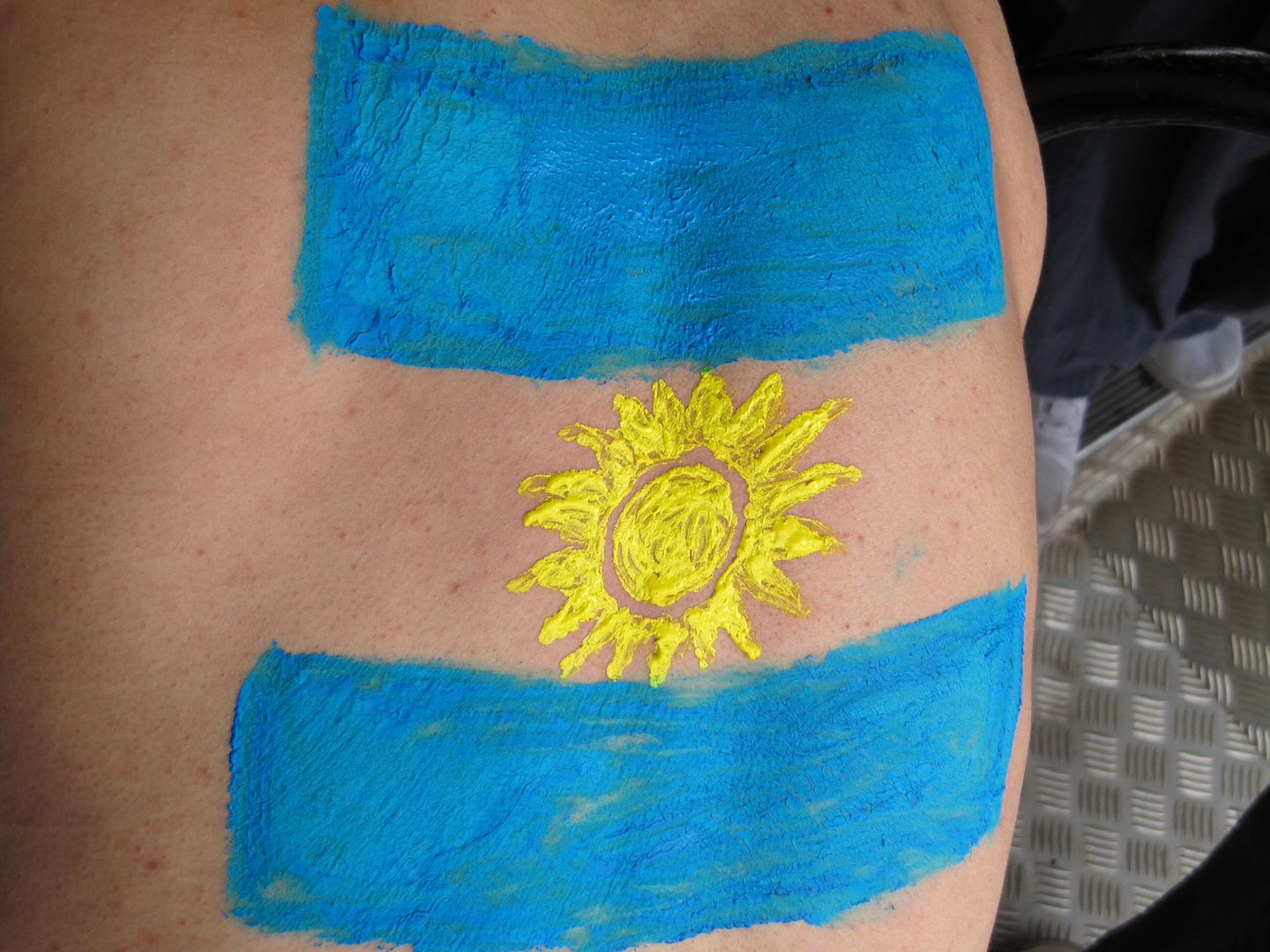 |
| the painted flag |
So Sharif (you may as well know who it was as there are plenty of pictures) was painted in the flag, made his was onto the roof of the truck and started to dance, much to the confusion and amusement of the bystanders.
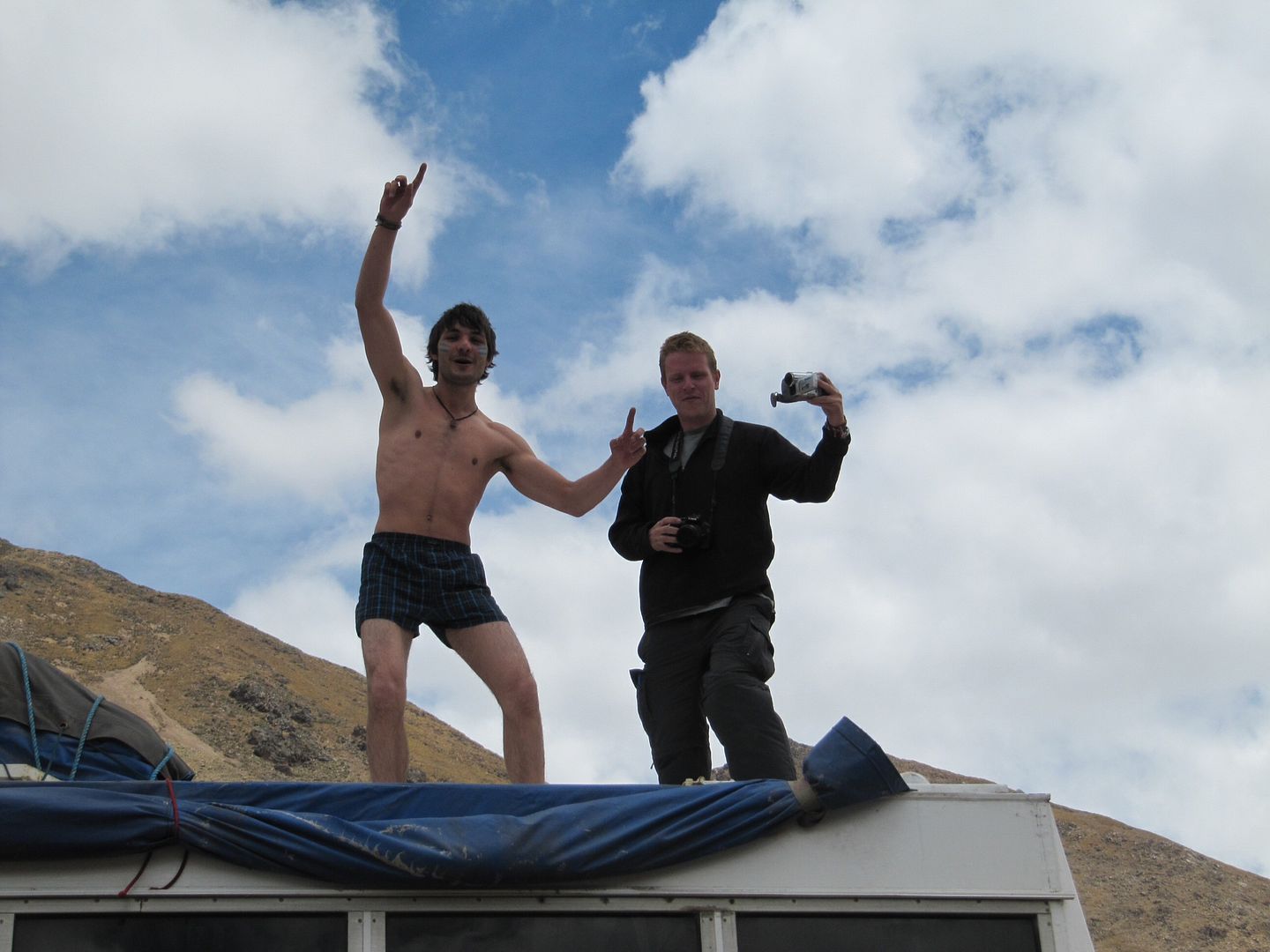 |
| Sharif truck dancing |
It isn't really a scene that you can describe, but suffice to say that when we played back the video, we saw a car drive past and then come back again, presumably to check that they really had just seen an almost naked man dancing on the top of a big orange truck!
Sunday, September 25, 2011
Busking while you eat
While we were eating in Copacabana, a woman came in to play a few traditional tunes on her flutes, one of which was a double flute that sounds like you are playing two different instruments at once. Of course the hat then comes around for a donation.
That kind of thing is quite common here, as in some of Europe, but I find it a bit irritating. It's OK if the person is good, and you enjoy the music or songs. Then I am happy to give them a bit of change, especially when it gives me a taste of the local music and so I feel like I have gained something.
Sadly though, quite often they aren't any good at all, and you spend the time wishing they would go away and let you eat in peace - and then they get grumpy when you don't give them anything. And often it isn't just the one that turns up. You get a succession of them coming through, as well as the people who come in trying to sell you biros or torches etc.
In this case, the woman with the flutes was fairly good so she got a donation, but when the guitarrist came round later he wasn't great so got nothing. I used to feel bad about things like that, partly because I know that a couple of pesos is nothing much to me but can be a lot for them. But I don't feel bad anymore, especially since I noticed that the locals don't feel obliged to give anything themselves. Not that I have yet been brave enough to do what one of our group did an when the hat came round simply say I didn't like it. Maybe next time.
That kind of thing is quite common here, as in some of Europe, but I find it a bit irritating. It's OK if the person is good, and you enjoy the music or songs. Then I am happy to give them a bit of change, especially when it gives me a taste of the local music and so I feel like I have gained something.
Sadly though, quite often they aren't any good at all, and you spend the time wishing they would go away and let you eat in peace - and then they get grumpy when you don't give them anything. And often it isn't just the one that turns up. You get a succession of them coming through, as well as the people who come in trying to sell you biros or torches etc.
In this case, the woman with the flutes was fairly good so she got a donation, but when the guitarrist came round later he wasn't great so got nothing. I used to feel bad about things like that, partly because I know that a couple of pesos is nothing much to me but can be a lot for them. But I don't feel bad anymore, especially since I noticed that the locals don't feel obliged to give anything themselves. Not that I have yet been brave enough to do what one of our group did an when the hat came round simply say I didn't like it. Maybe next time.
Puno and the Floating Reed Islands
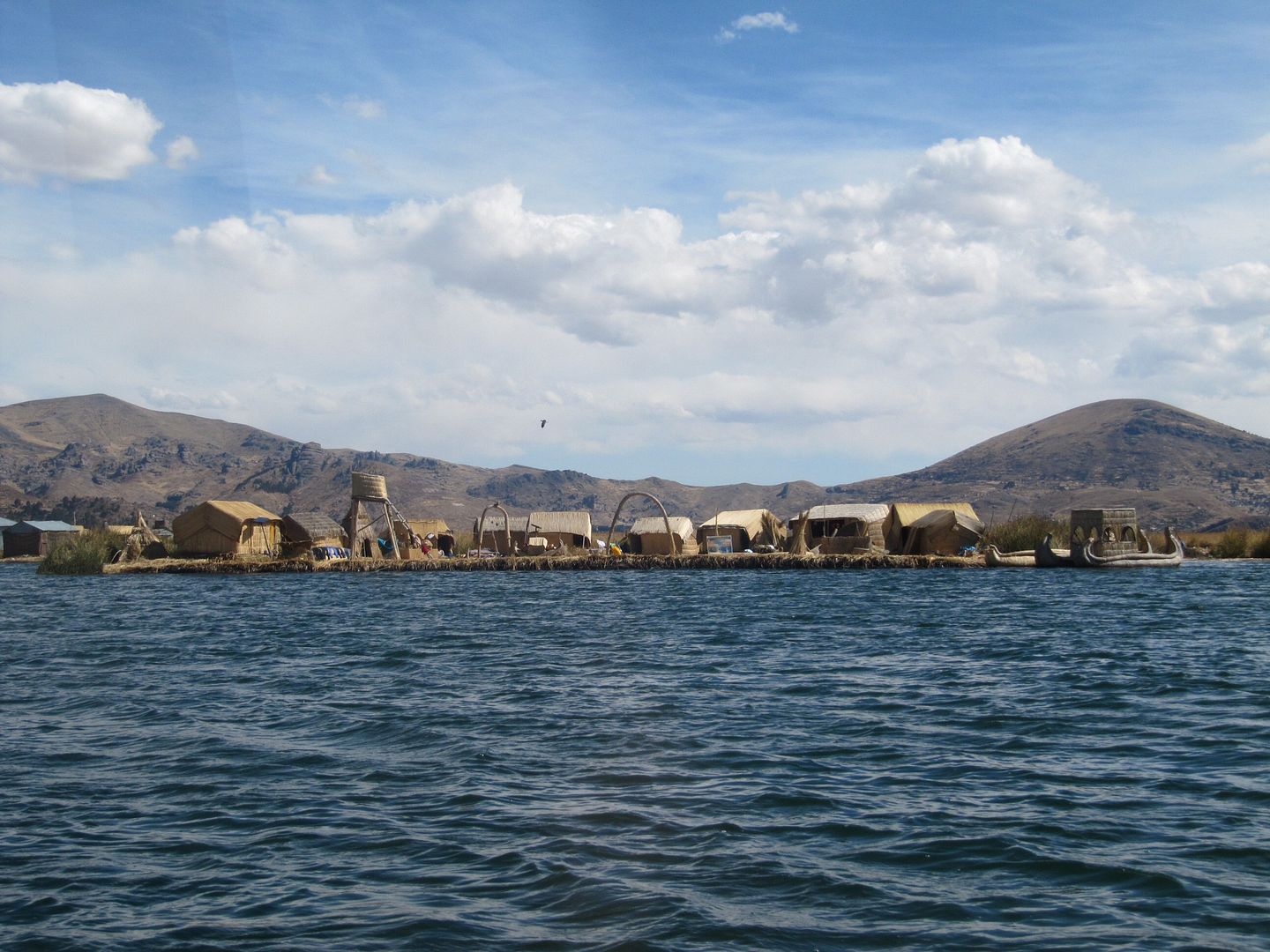 |
| Floating reed islands, Puno, Peru |
Our next stop was still on Lake Titicaca, but further around to place called Puno. After a quick lunch on the lake front, having run the gauntlet of people calling to us to eat in their place, we picked up a local guide for another boat trip, this time to the floating reed islands.
I know that on a tour like this one, it is all planned and the people concerned use the tourism to make a living, either through a feeAdd caption from the tour or by selling their crafts to the visitors. It was made clear to us that these people were happy to have us visit and take photos, whereas there are some on other islands who do not accept visits and who believe that taking their photo takes their soul, so they are left in peace.
 |
| Floating reed islands, Puno, Peru |
People having been living on the floating reed islands for centuries and we took a trip out to meet some of them and find out about their life on the lake. I'm not sure how I feel about this sort of tourism. I like to see how different people live and learn something about their the culture and lifestyle, but I feel like I am intruding into something personal when they take you into their home.
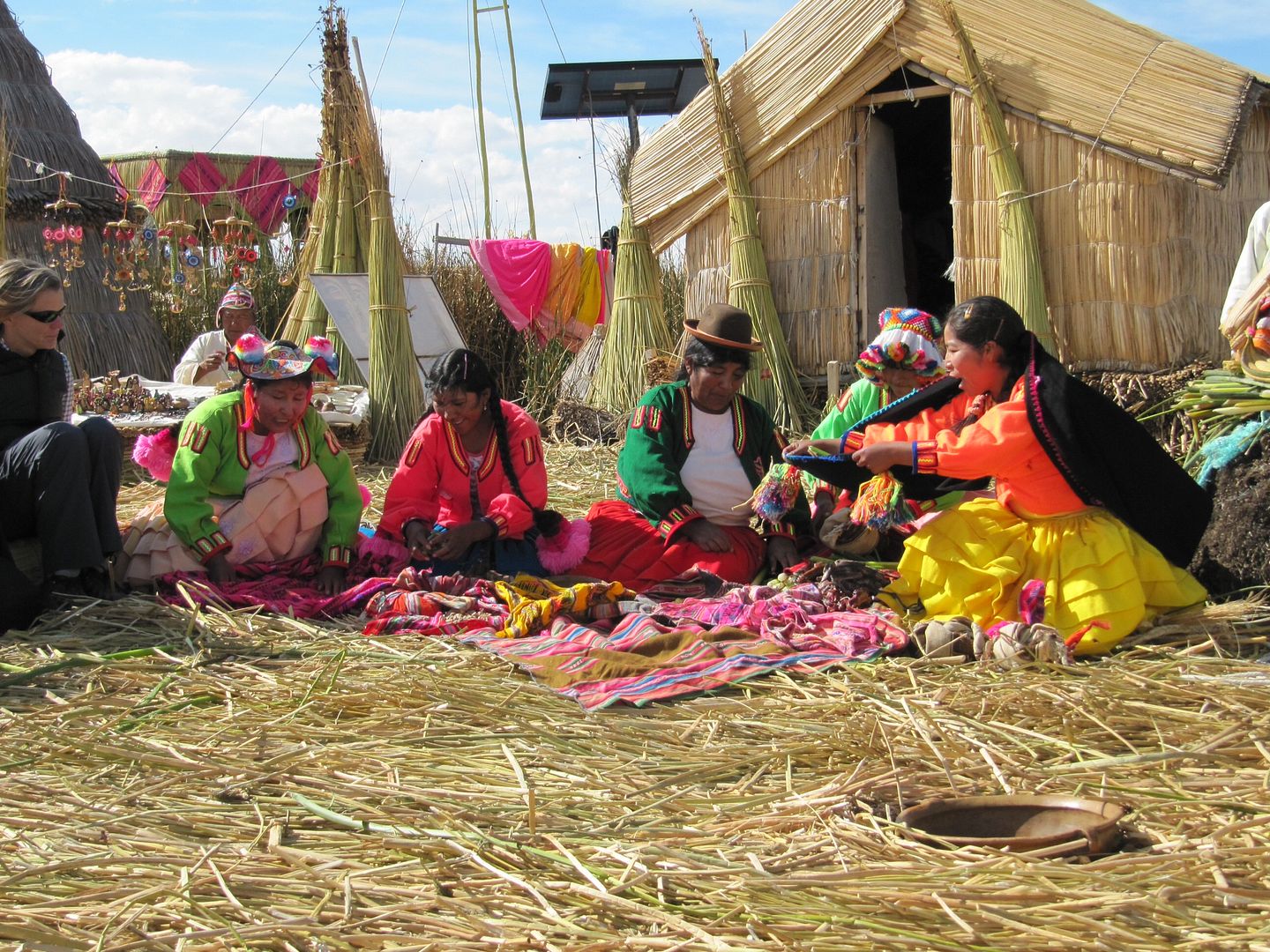 |
| trading on the reed islands, Puno, Peru |
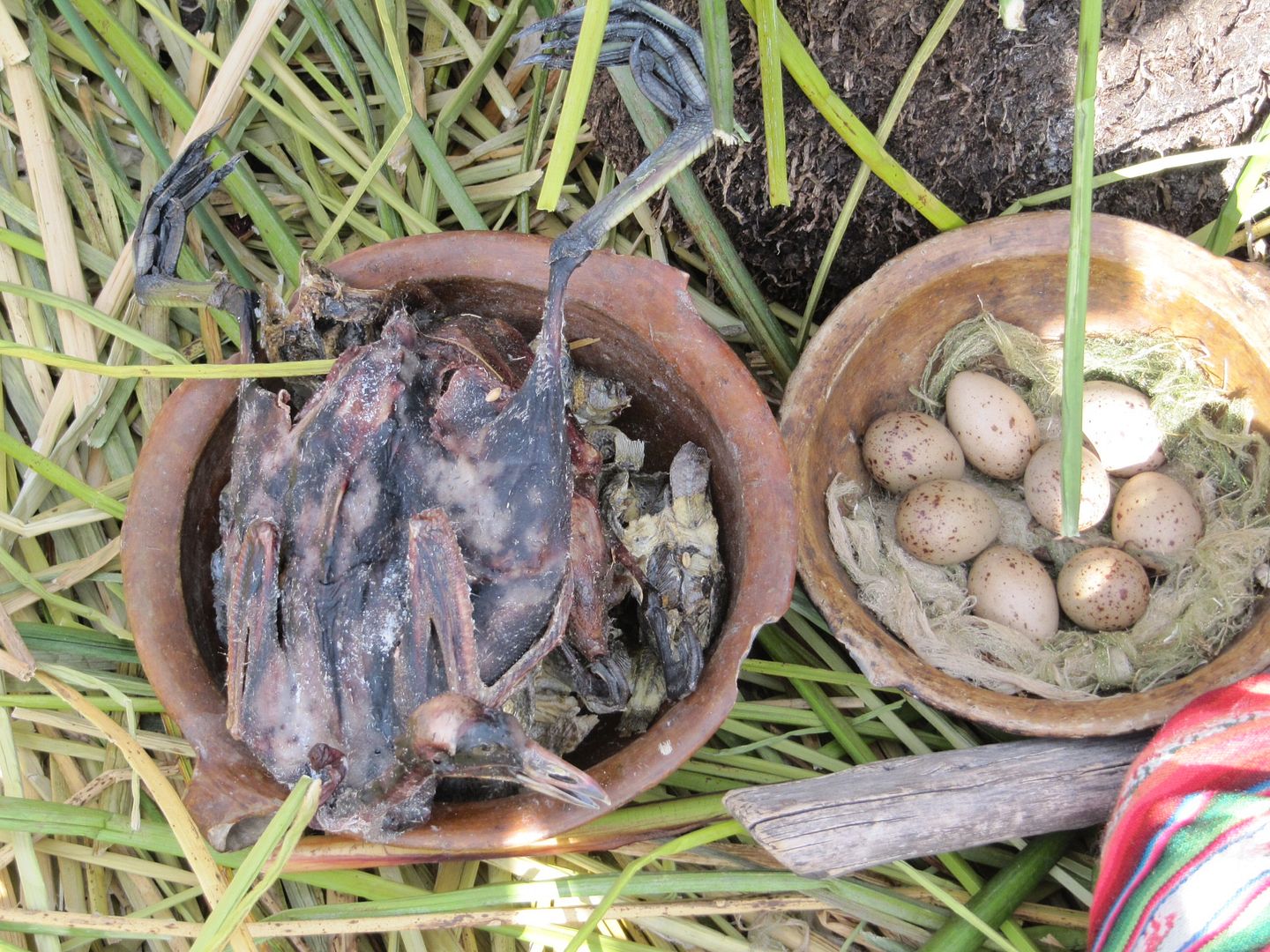 |
| food on the floating reed islands |
 |
| Floating reed islands, Puno, Peru |
Then they sang us a couple of songs in the two local languages, Quechua and Aymara. That was a bit twee, but OK, as it showed us the different languages. Then they sang twinkle twinkle little star in English. Hmmm! There really wasn't any good reason for that.
 |
| dressed up on the reed islands |
Then they announced that they were gong to take us in small groups into their houses. This was a bit wierd and felt a bit intrusive, even if we did get the impression that a number of these people don't actually live on the islands any more. And then they dressed us up in their traditional clothes.
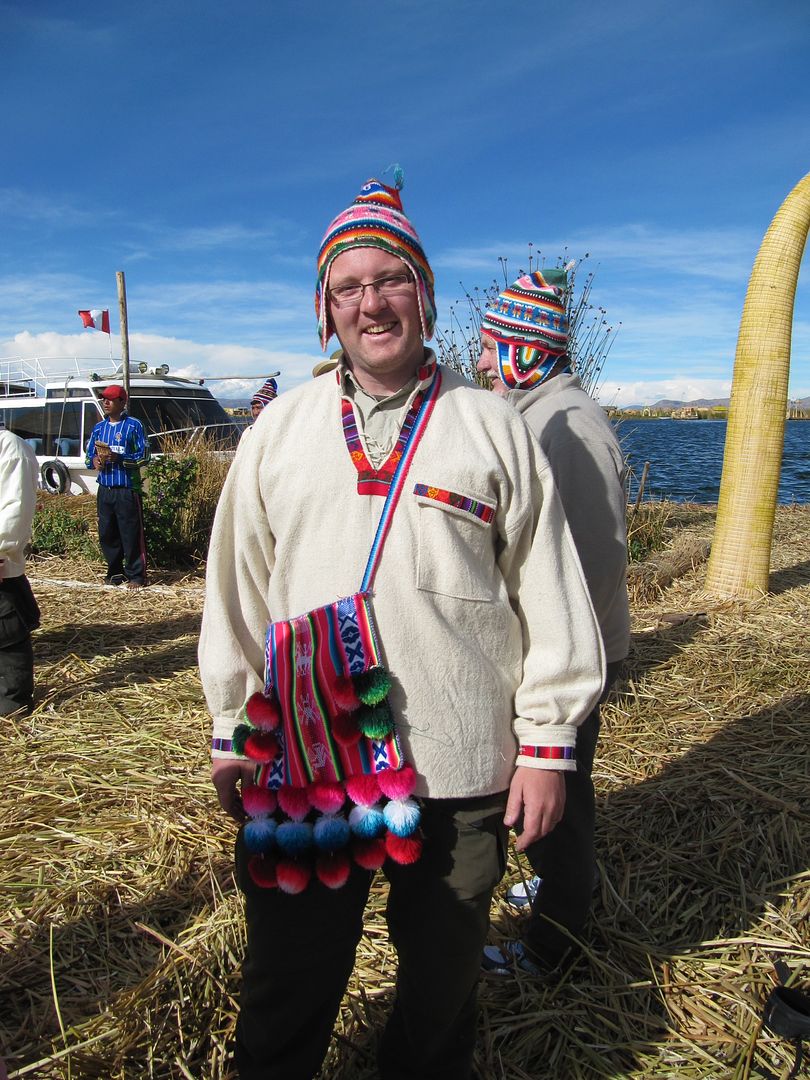 |
| dressed up on the reed islands |
For the boys this just meant a shirt, an woolly hat and a colourful 'man bag'.
For us girls we had big puffy skirts, waistcoats, things that looks like the big tassels that you tie curtains back with for our hair, and bowler hats. All in a variety of clashing colours. We looked like Boy George in the Karma Chamaeleon video!
After a communal dance that seemed a bit like the hokey cokey, we had a tour around the very small island. Knowing that guinea pig is a speciality in Peru, when we saw the group of them in the 'garden' one of the group asked if they were for eating. Our islander looked a little horrified and said that they were pets. Not entirely sure I believe this, as it seems that a floating reed island is not an ideal place to be able to support pets that don't pay their way, but I guess we'll never know for sure.
It was an interesting experience overall, though it is hard to know how much you see a real existence and how much is show for us. Obviously as soon as tourism impacts on a community then things change for the people, so there can't ever really be an authentic experience - even anthropologists studying remote tribes have to realise that the mere fact of their being there changes things - but it gives us some idea of what life was like. And I guess that as long as we recognise these limitations, and all parties are happy with what they get out of the deal, then there is no harm done.
 |
| Reed boat, Lake Titicaca, Peru |
Back on the mainland, we settled into our hotel for the night and then went out for a meal. I had my first opportunity to try out alpaca. It was nicer than llama, and not as beefy as many of the other animals seem to be, but it was nothing overly special. Guinea pig is next on the list, but I will wait until we get to Ariquipa for that.
Subscribe to:
Posts (Atom)